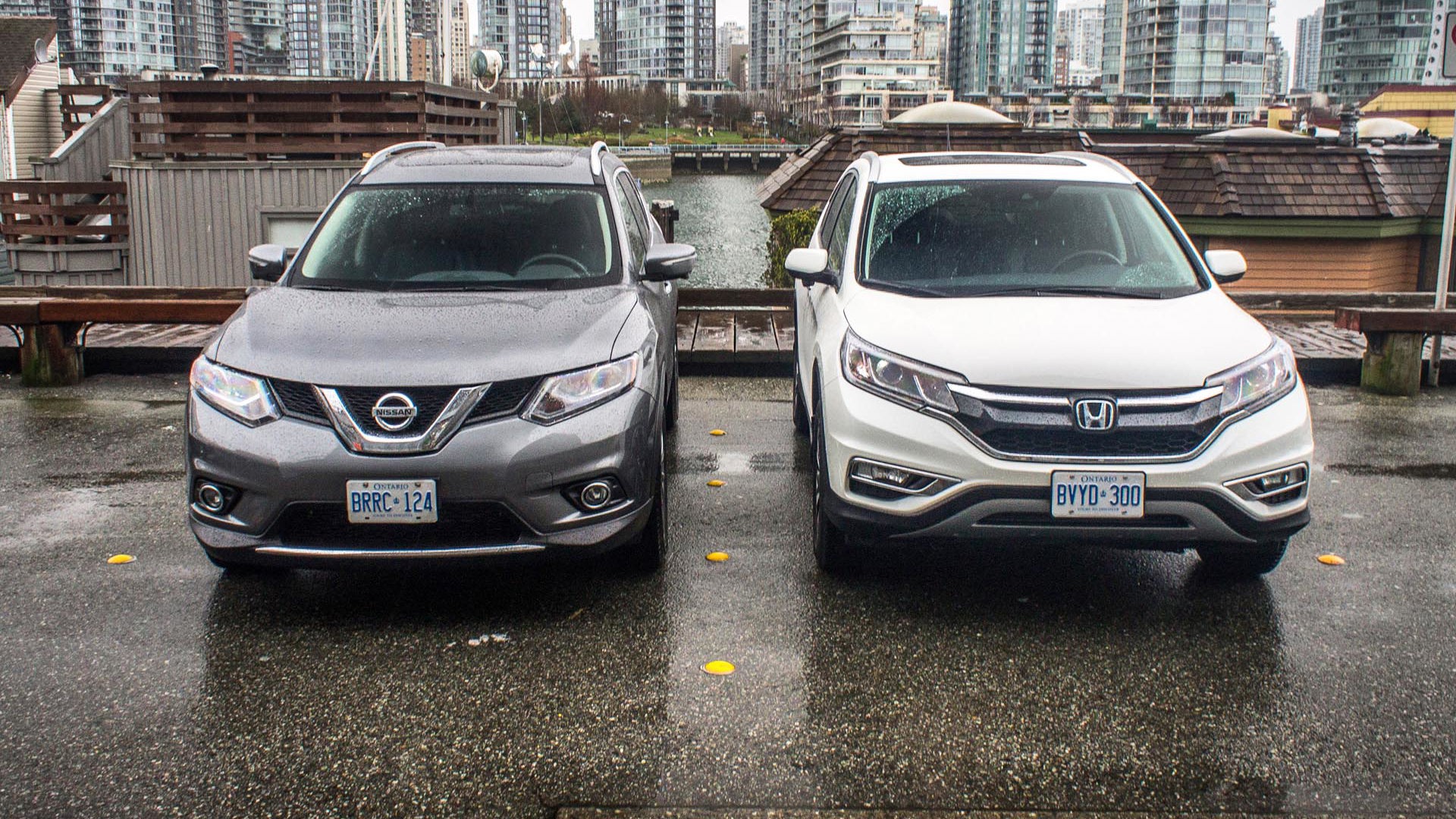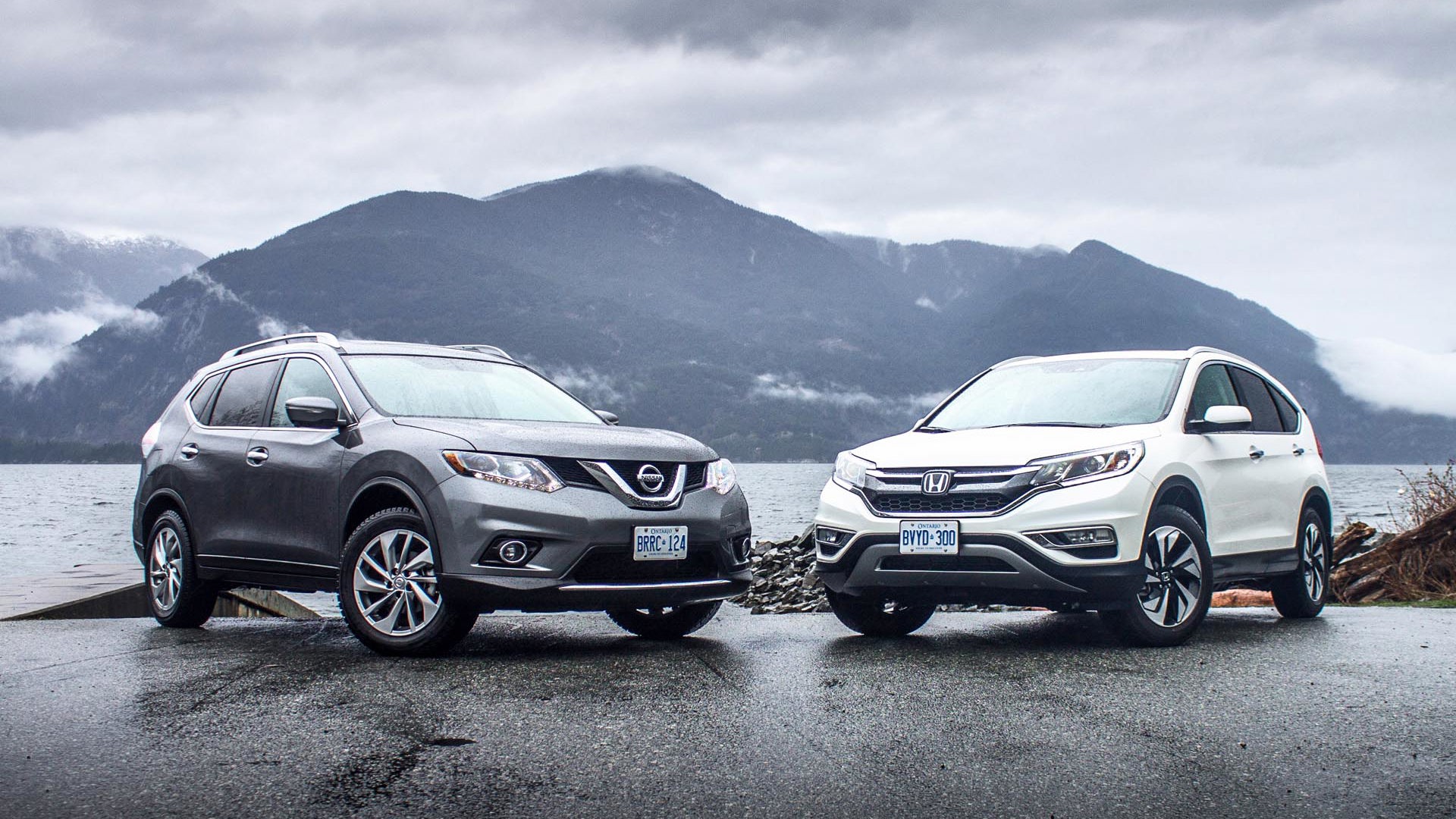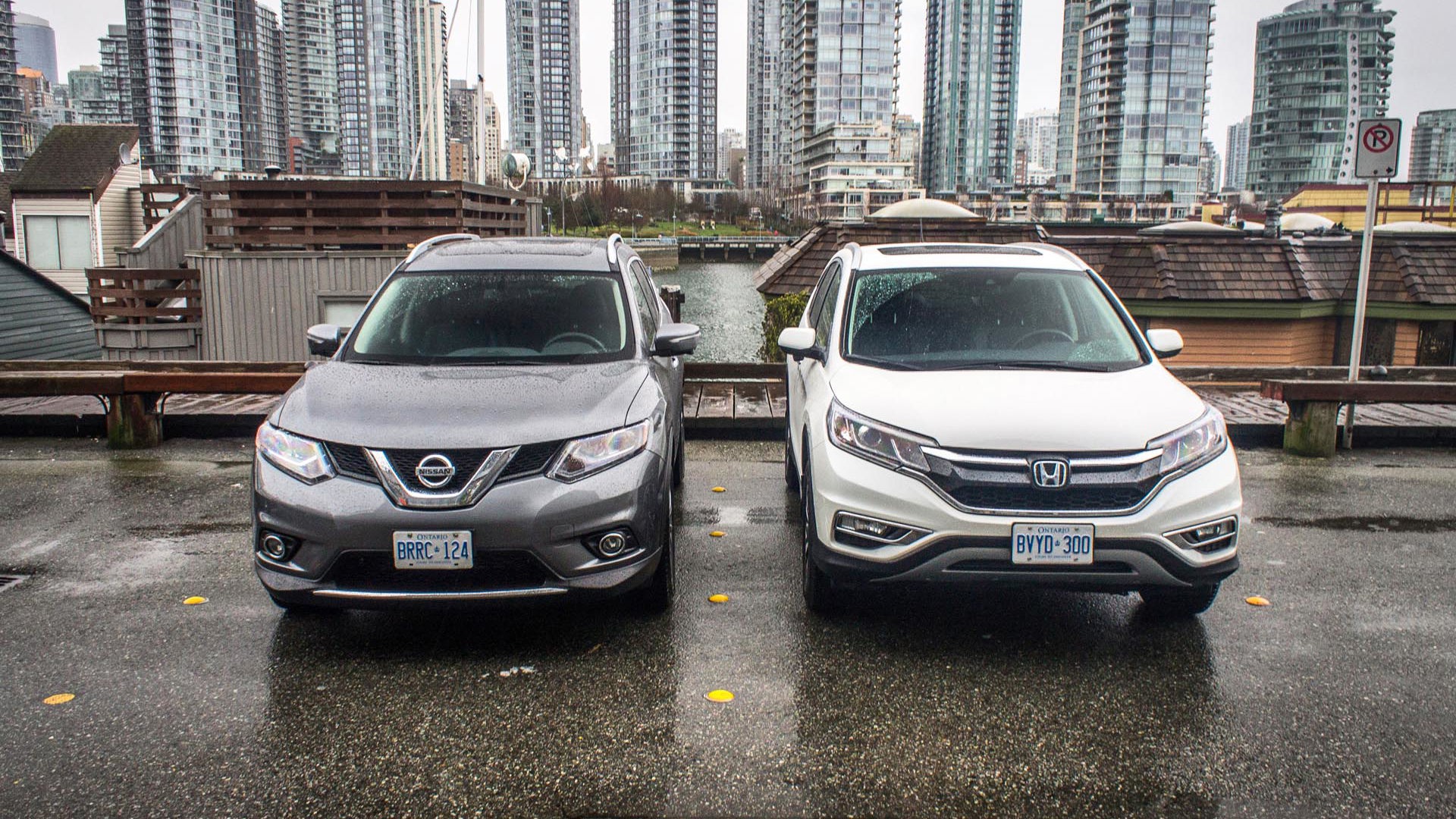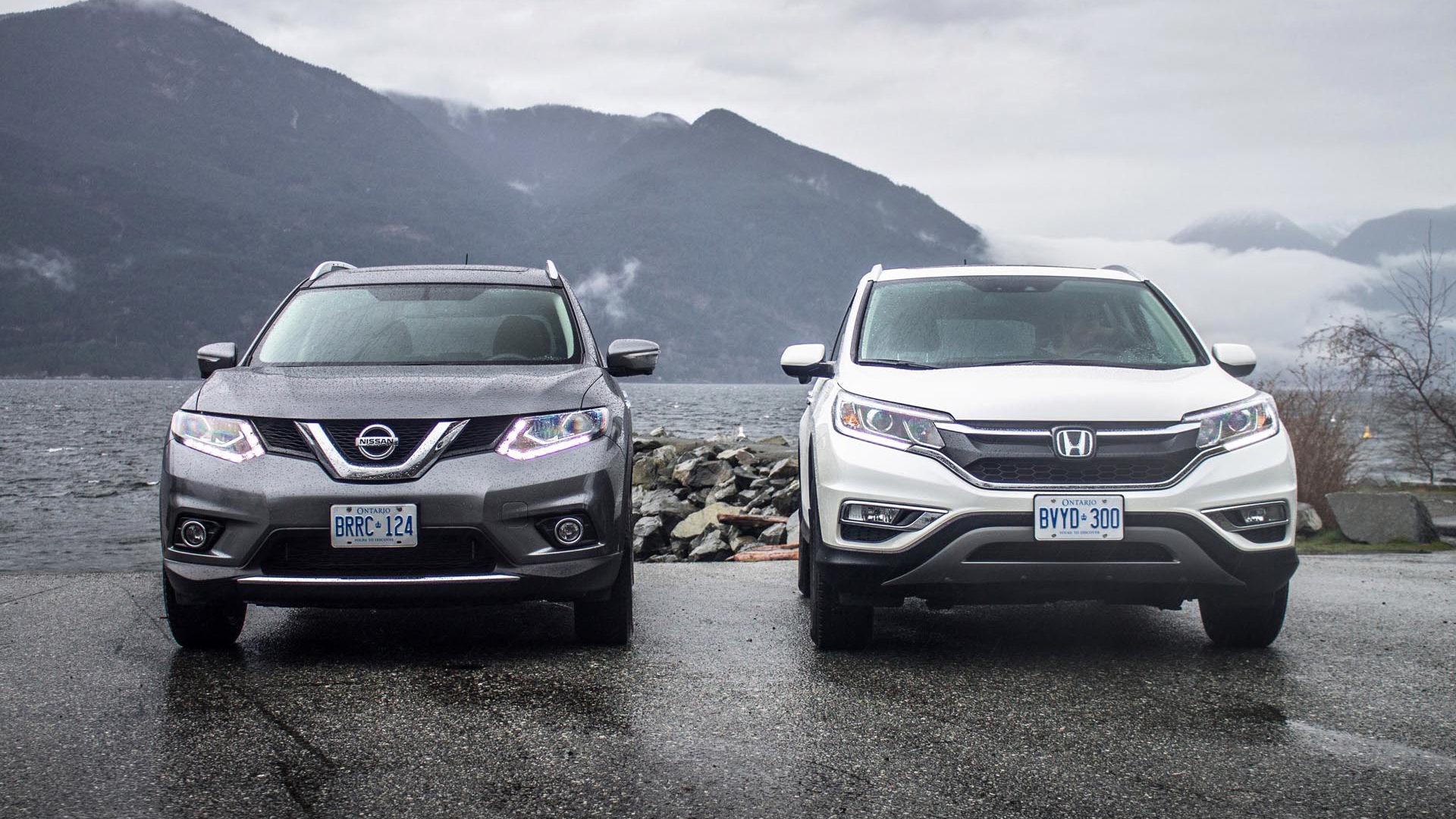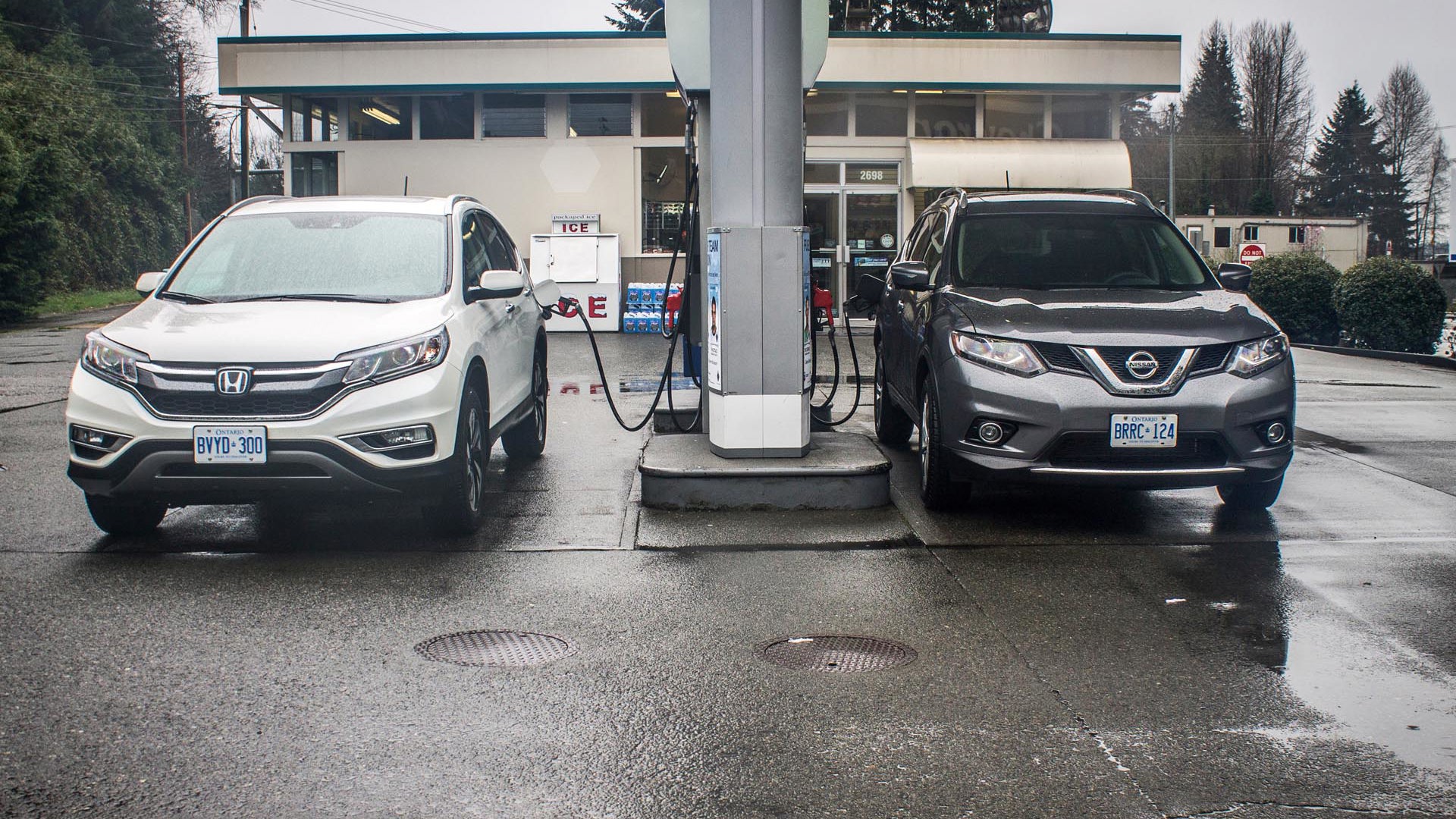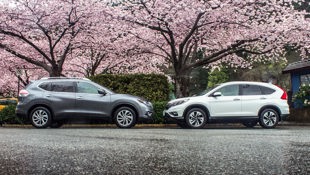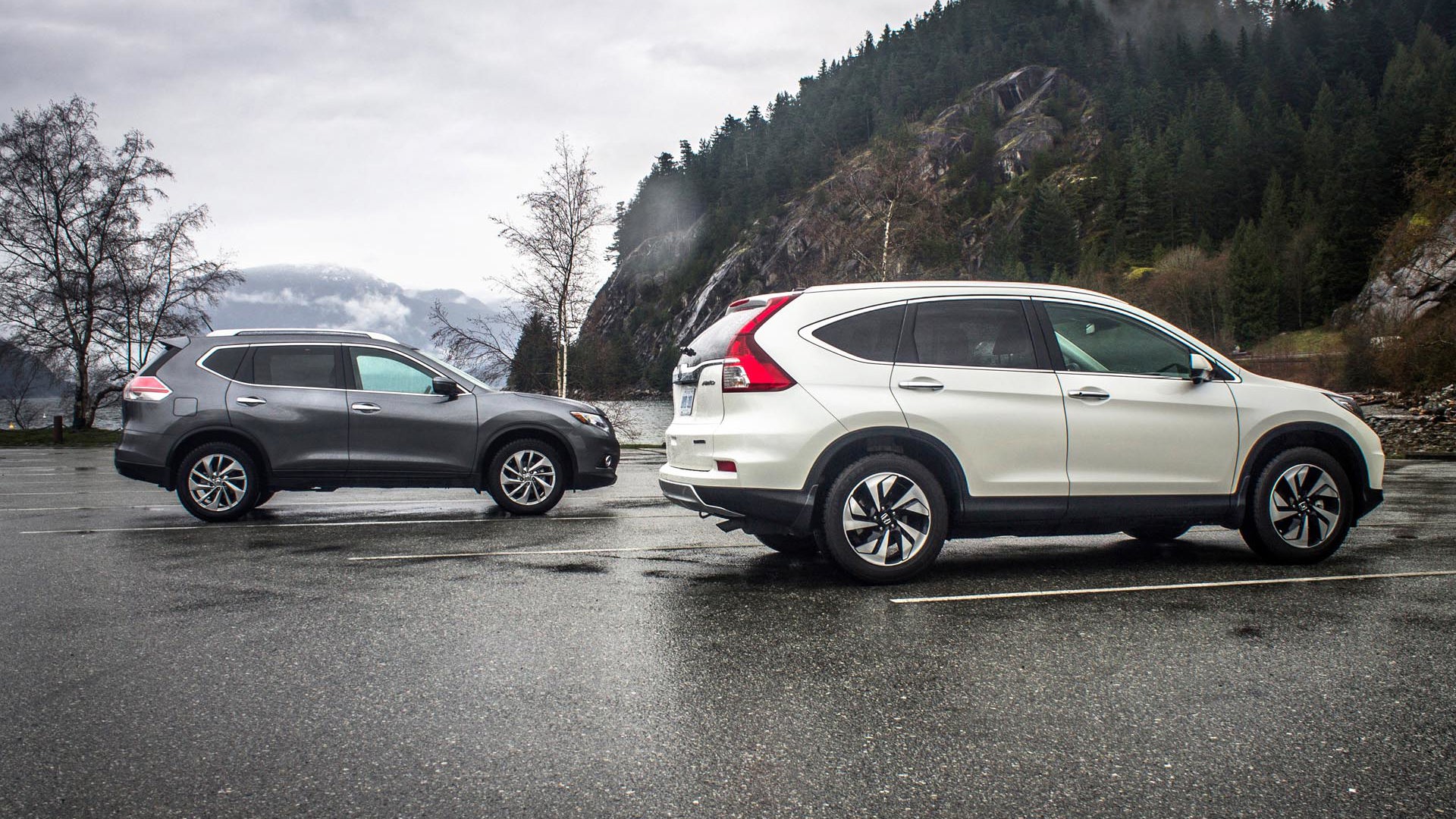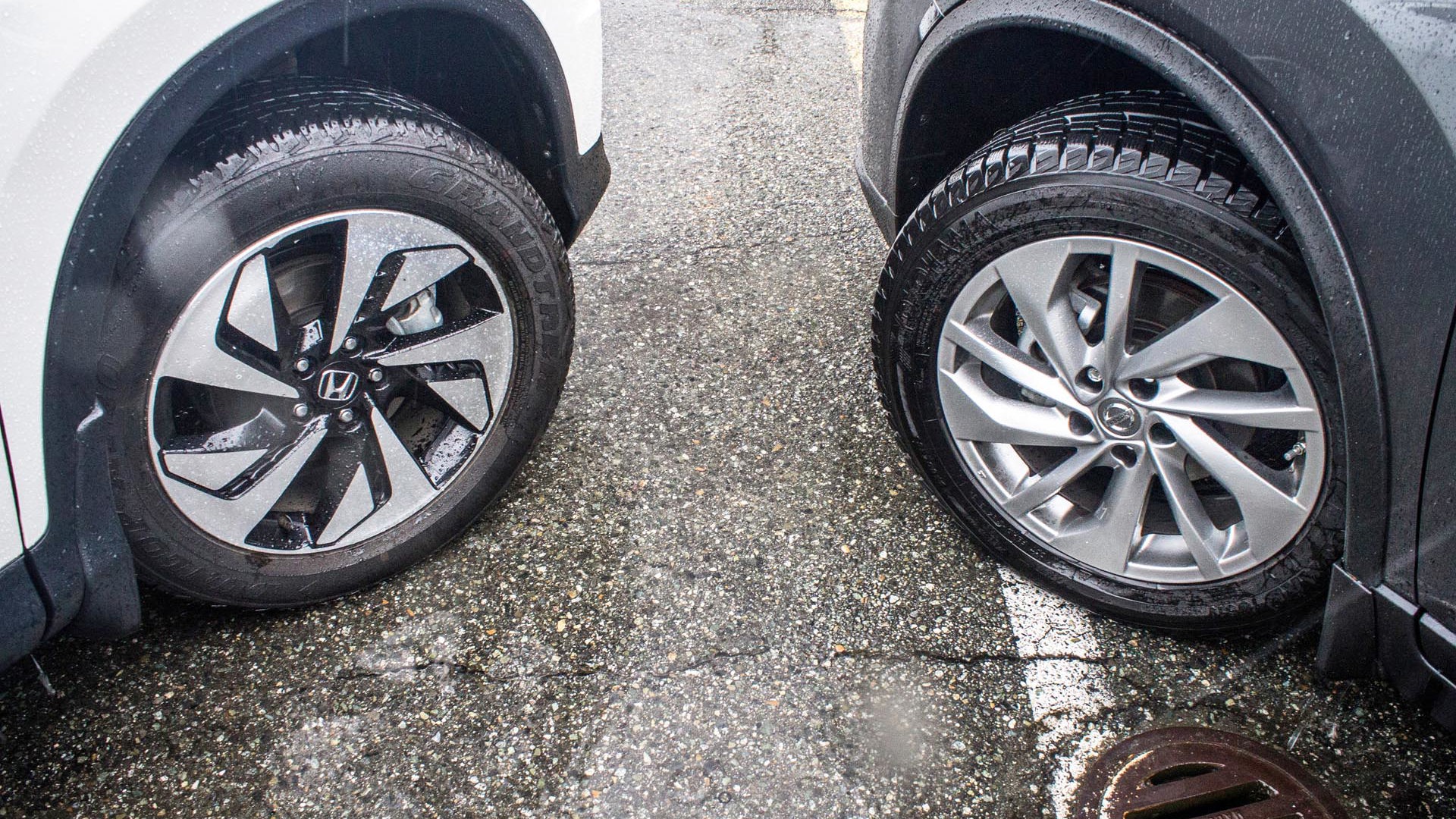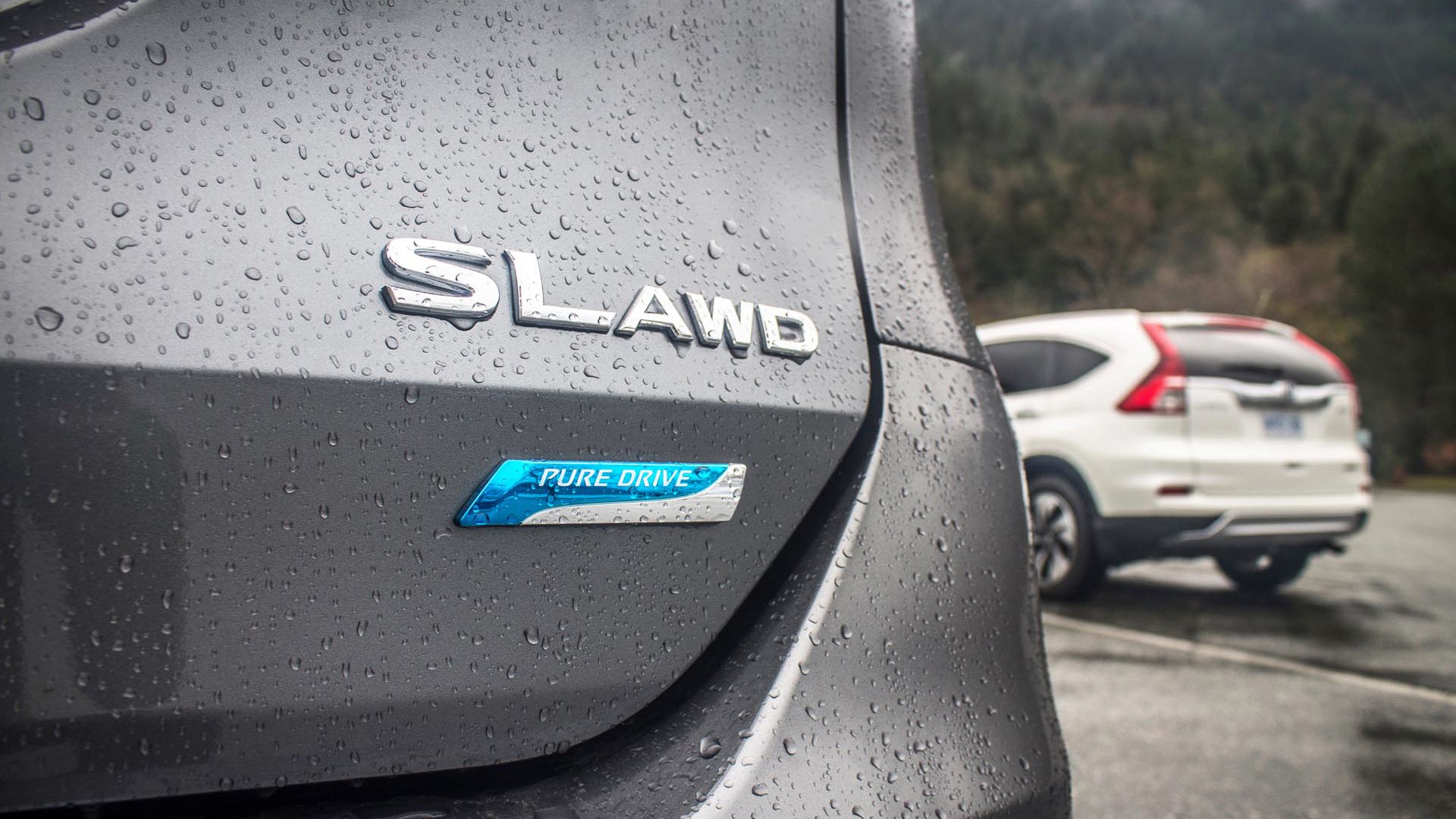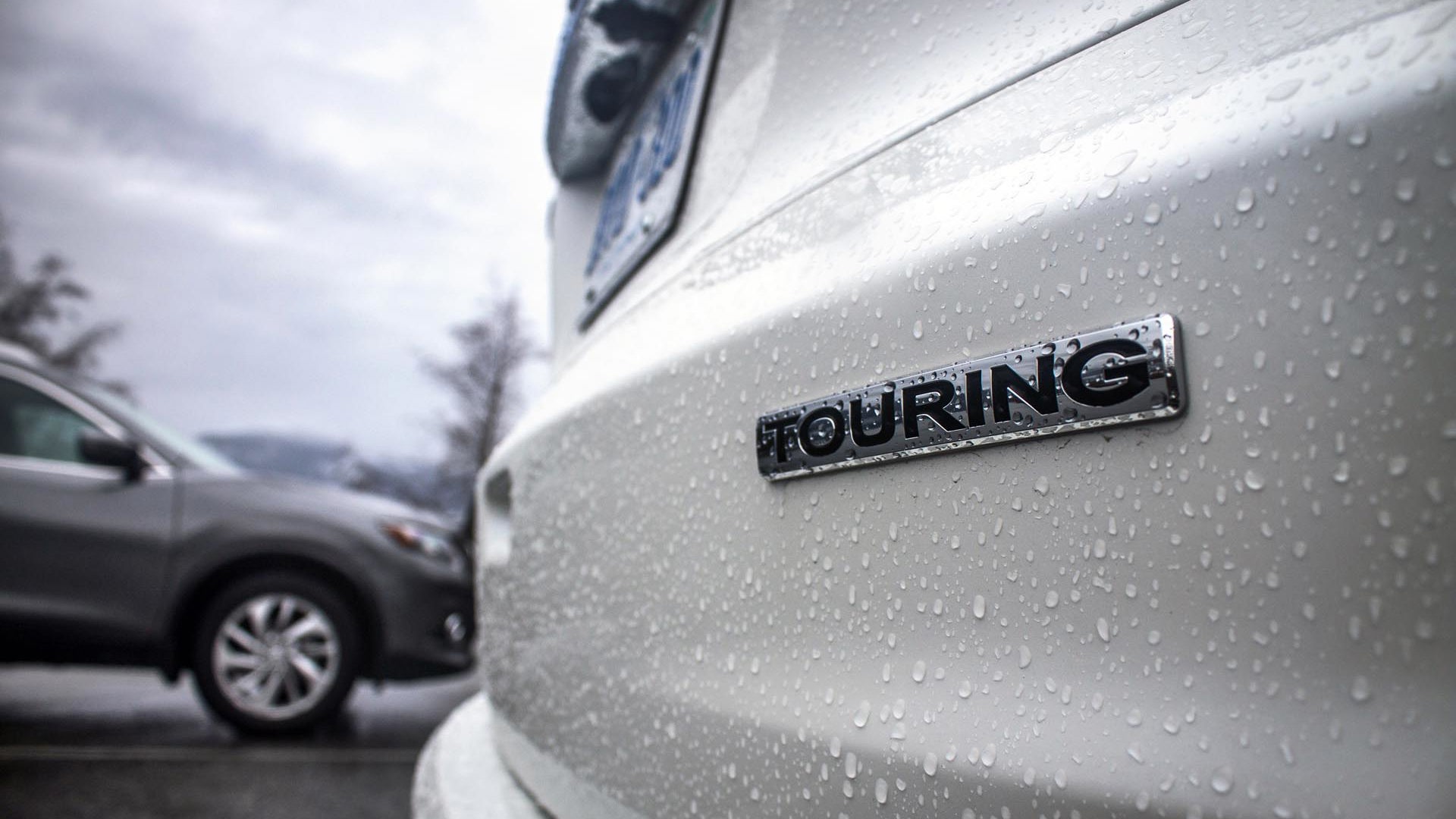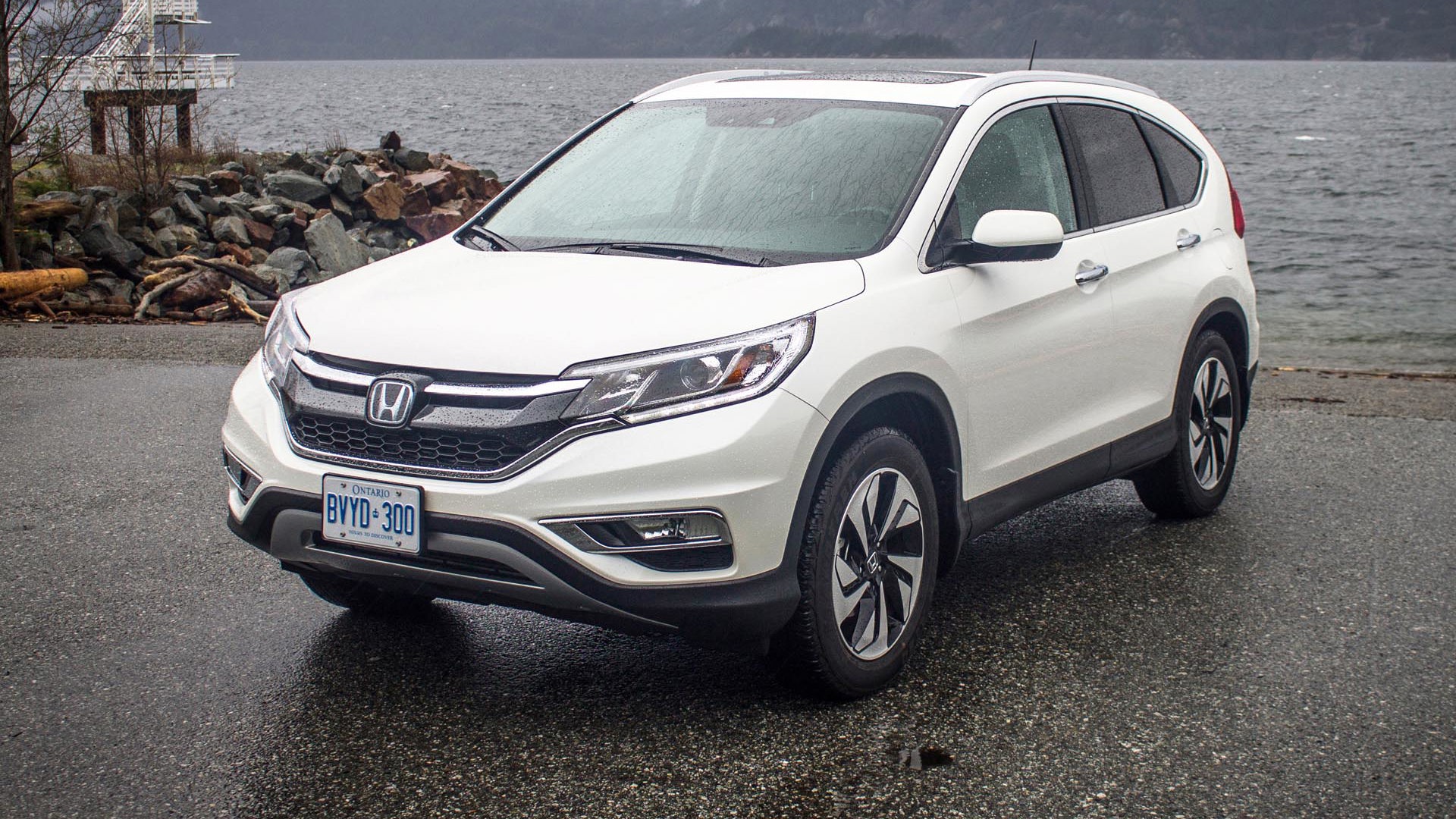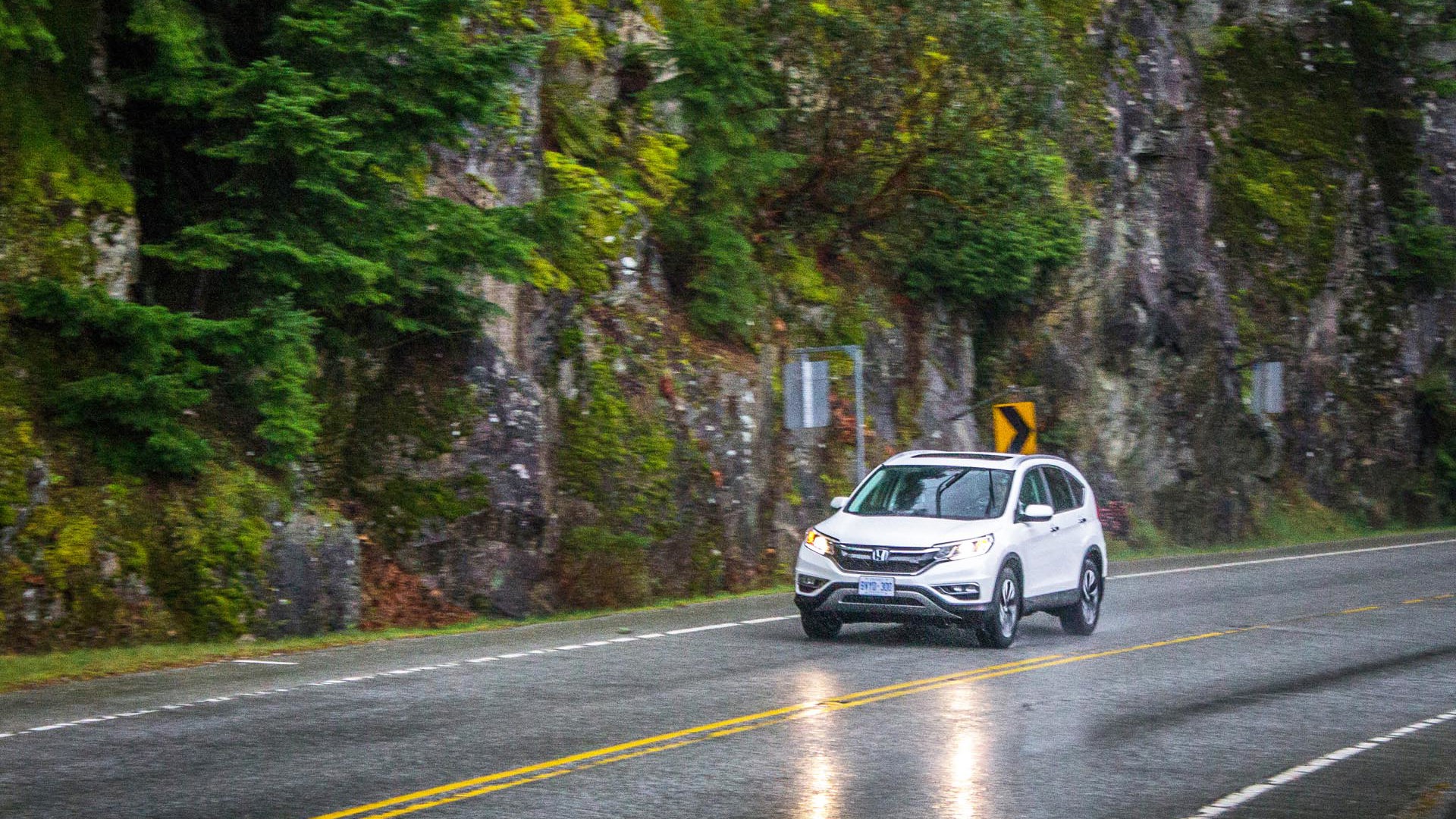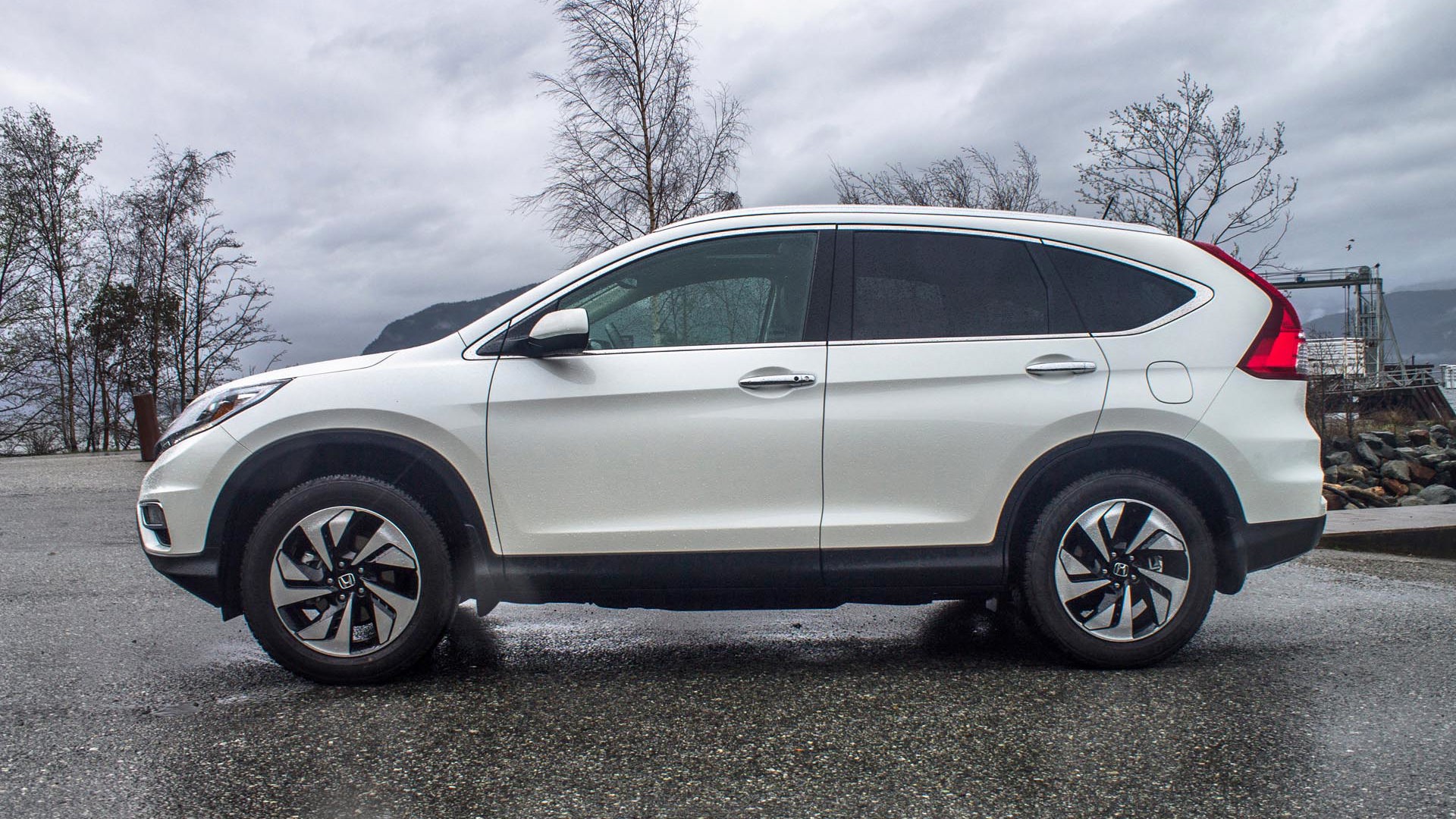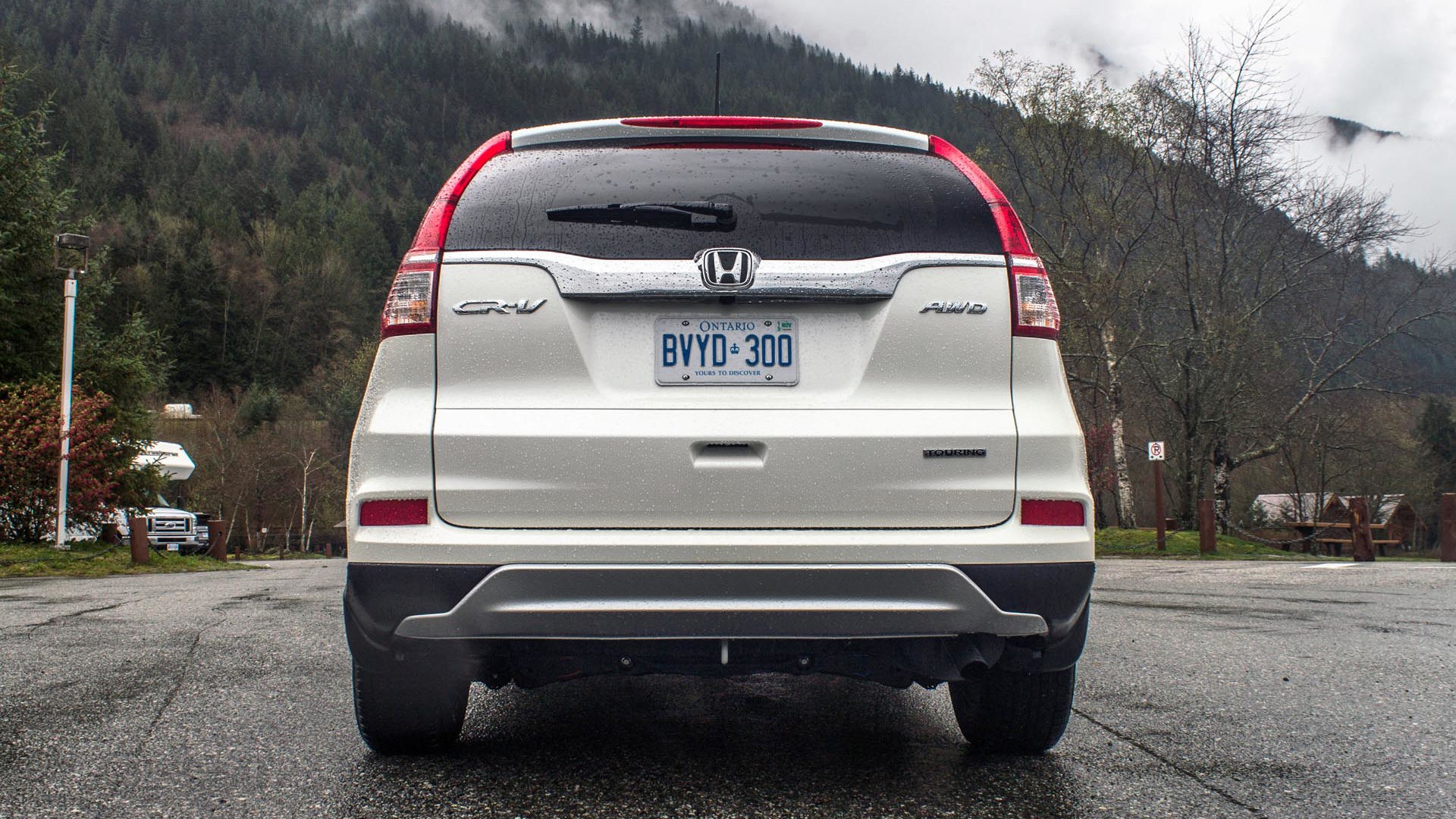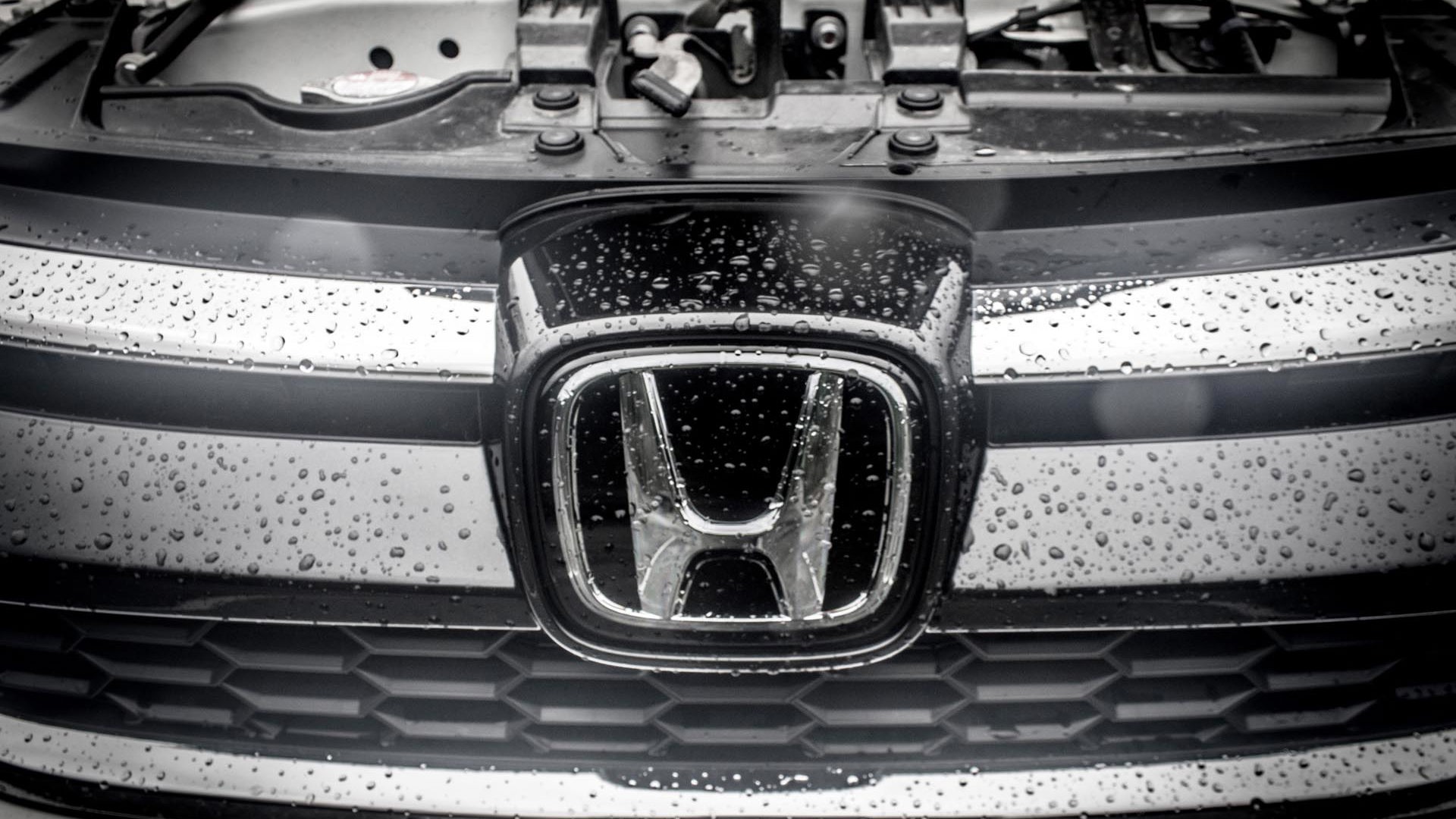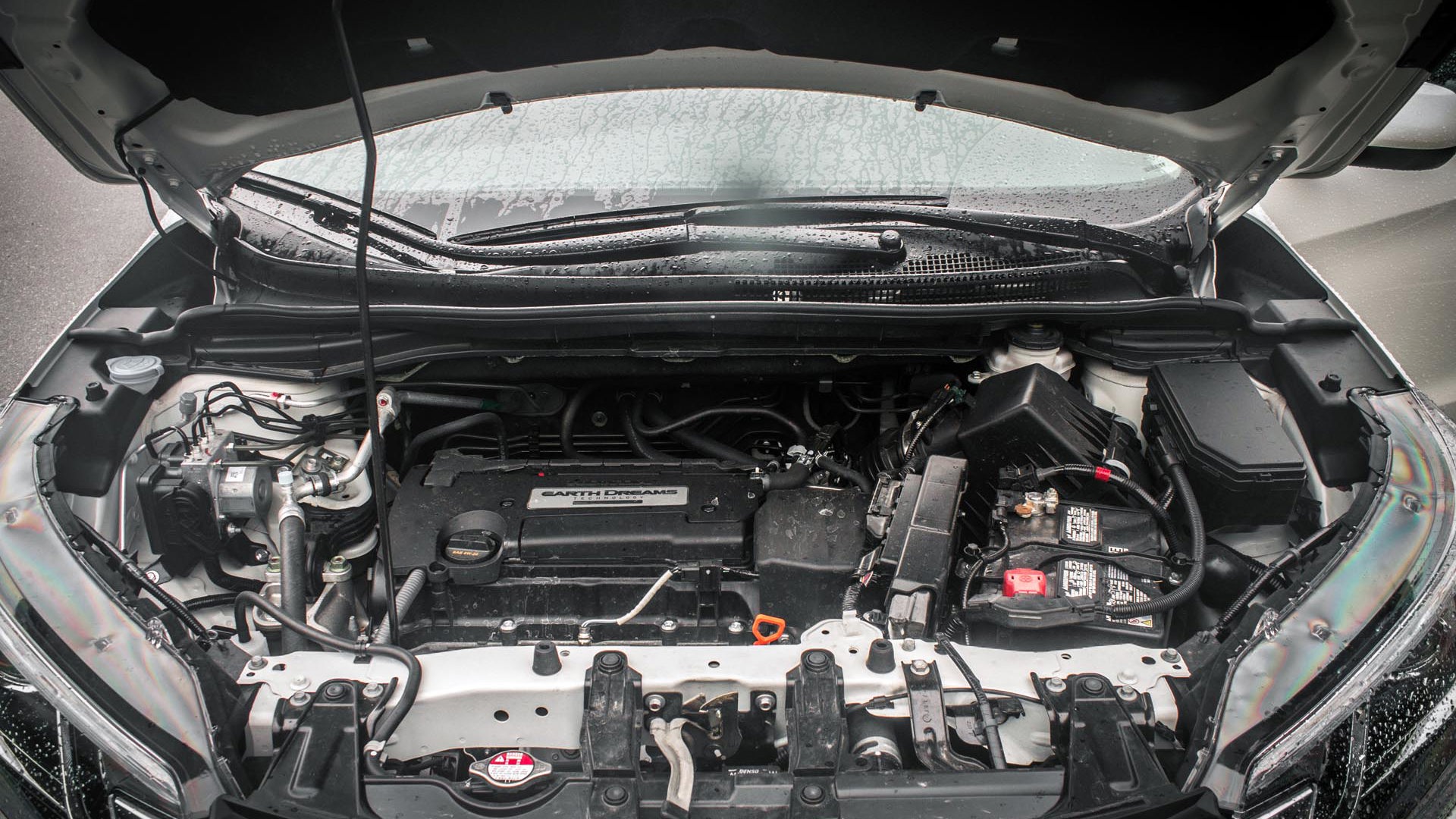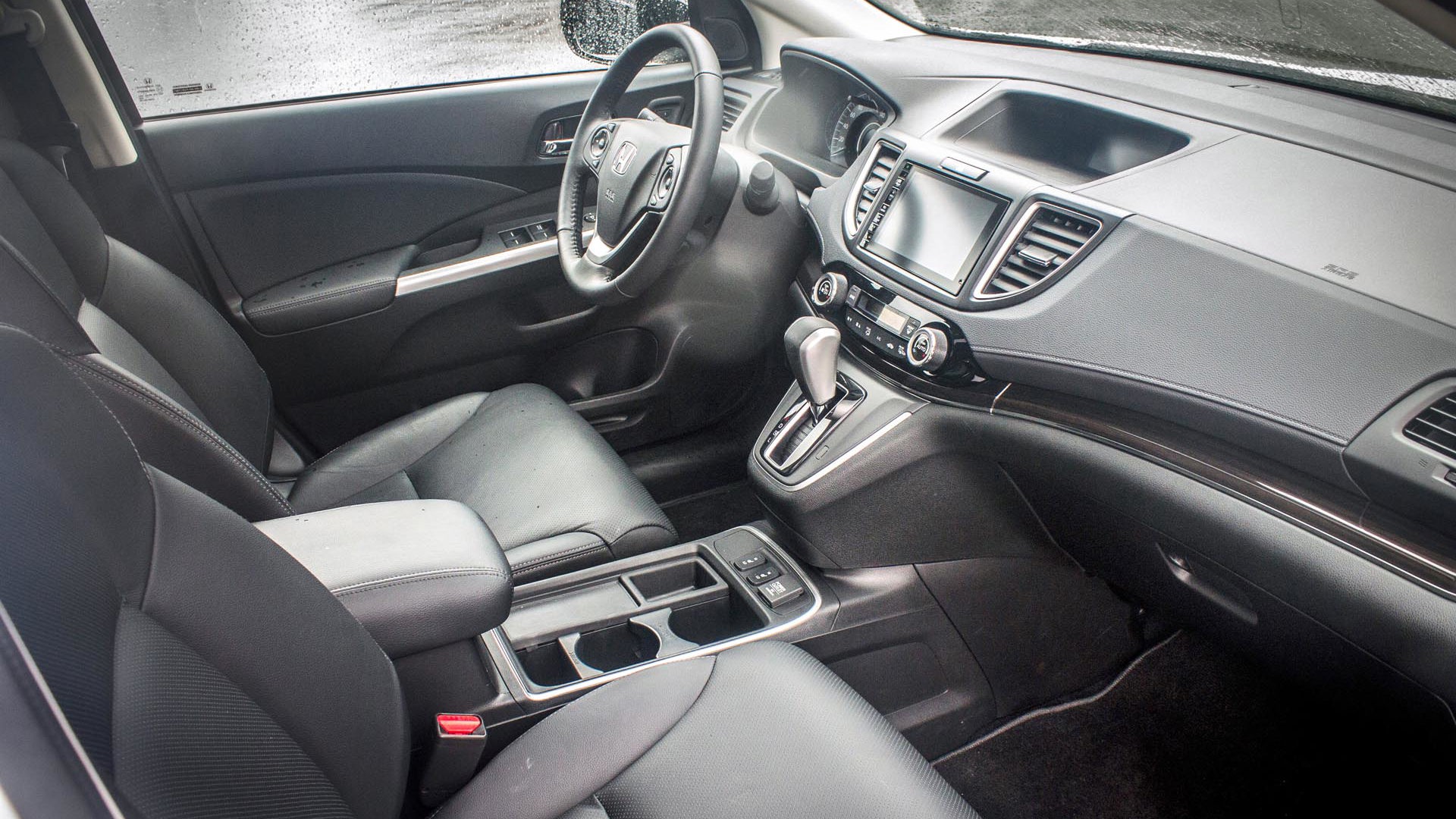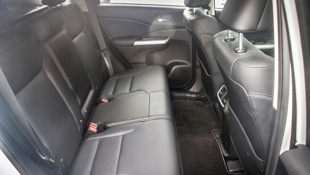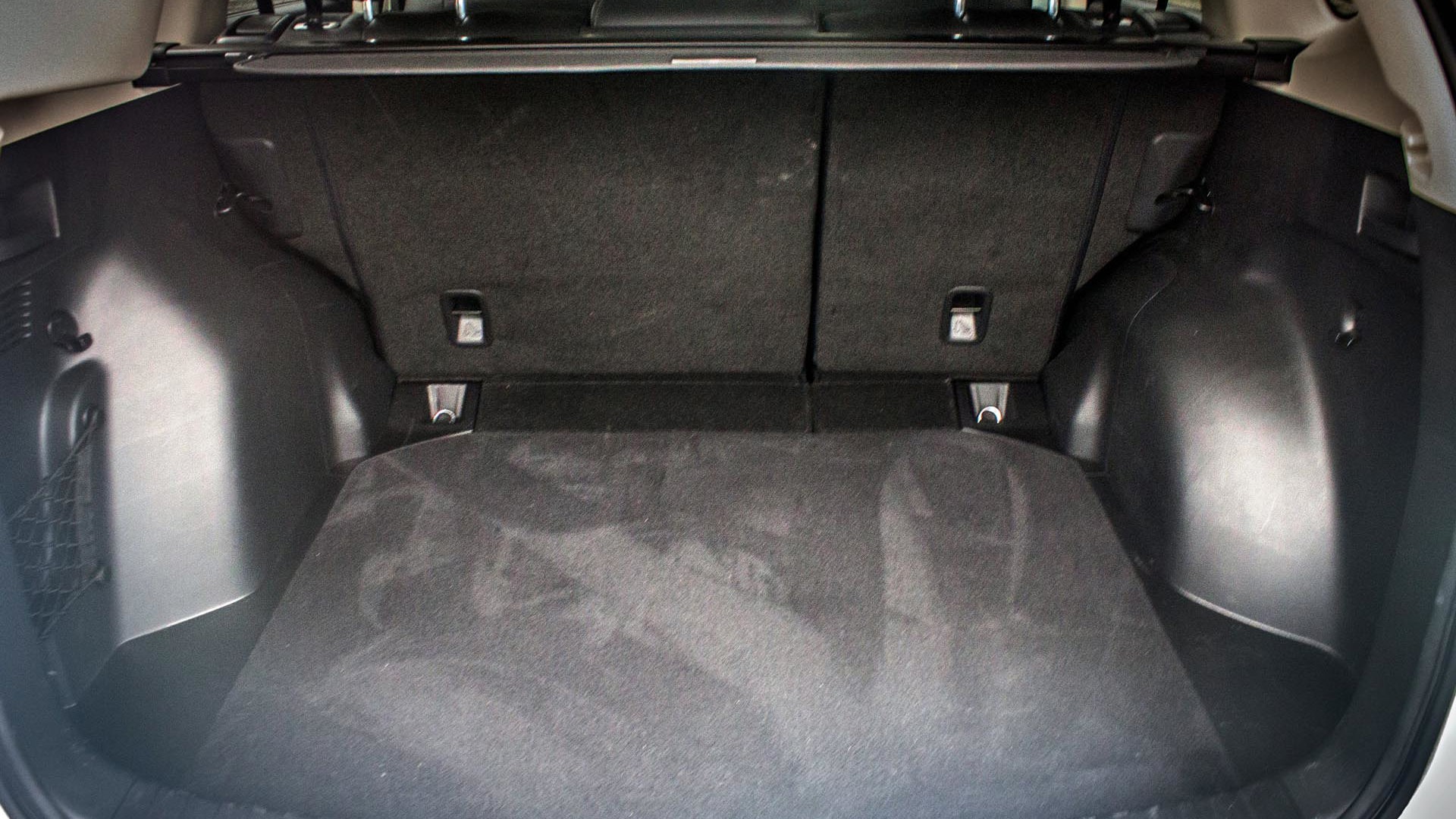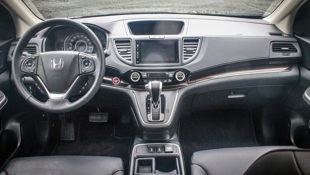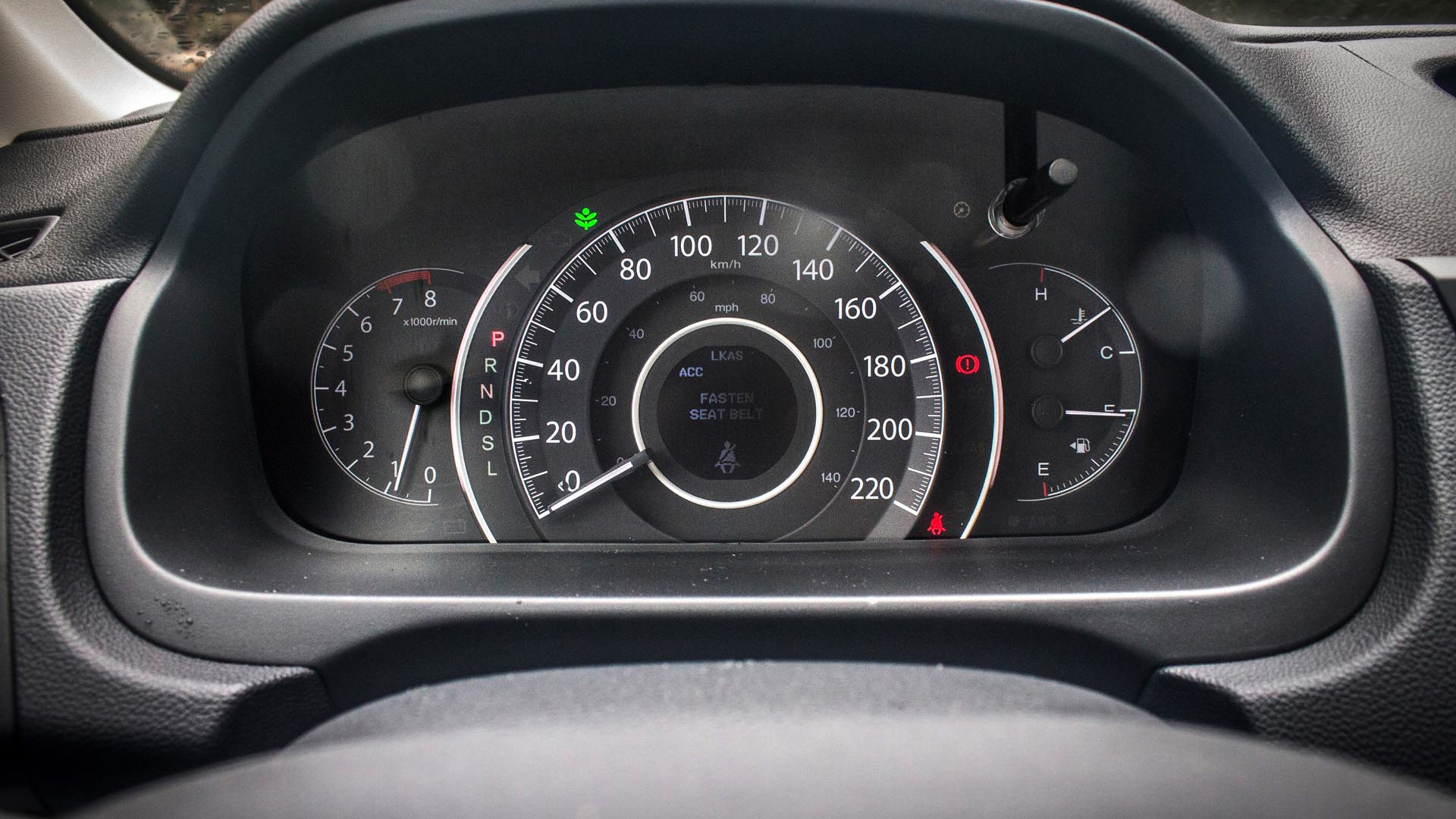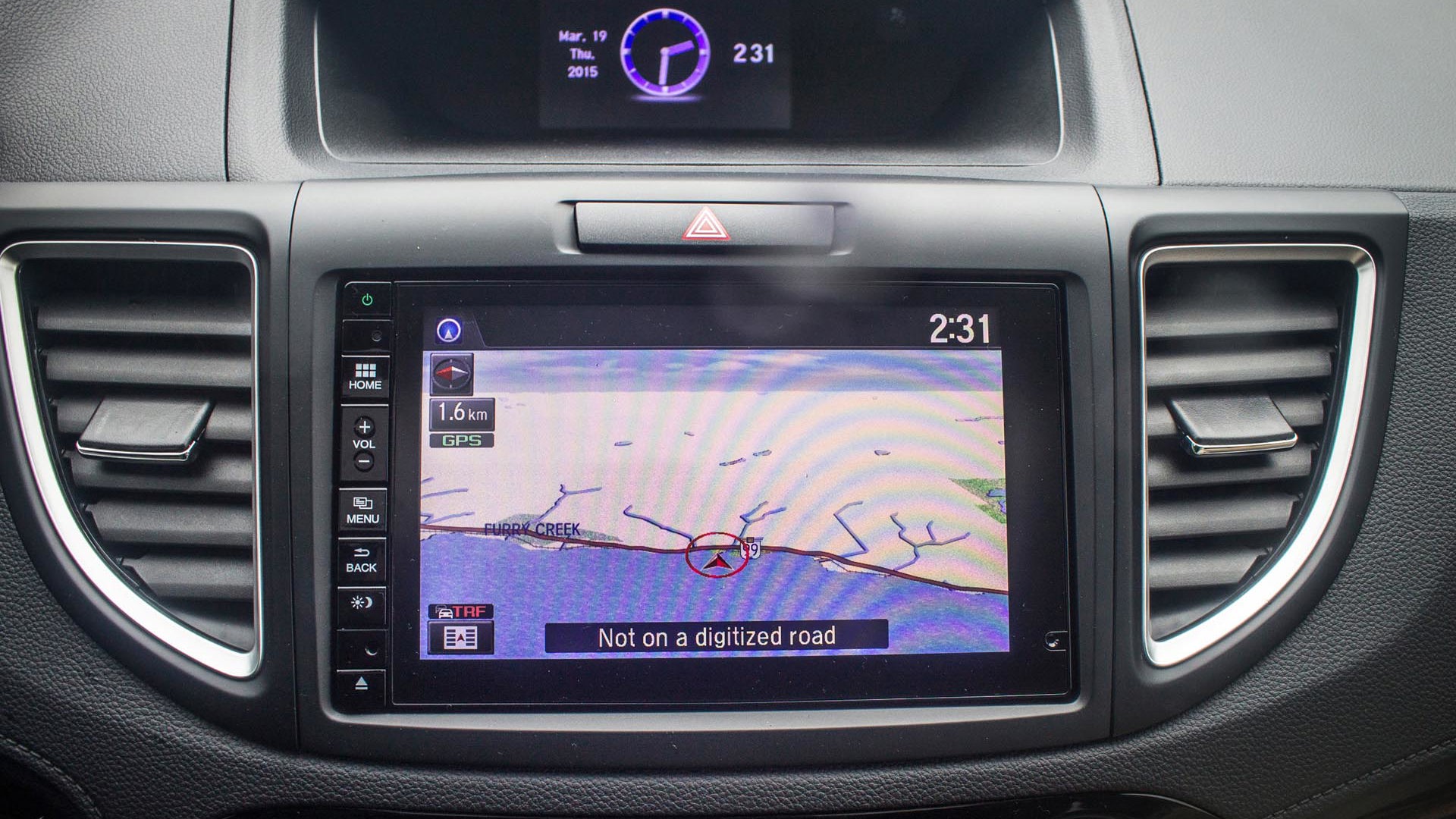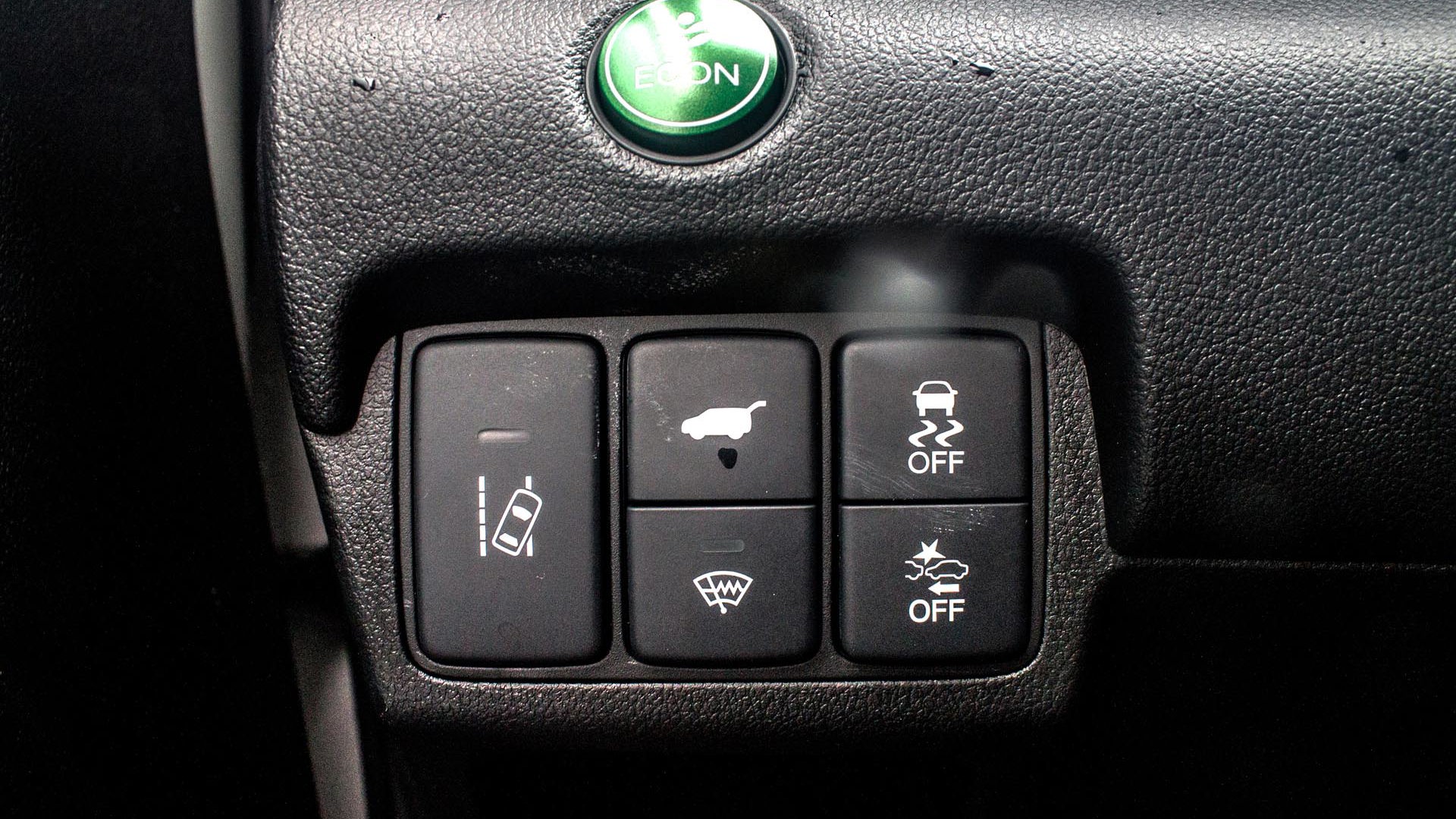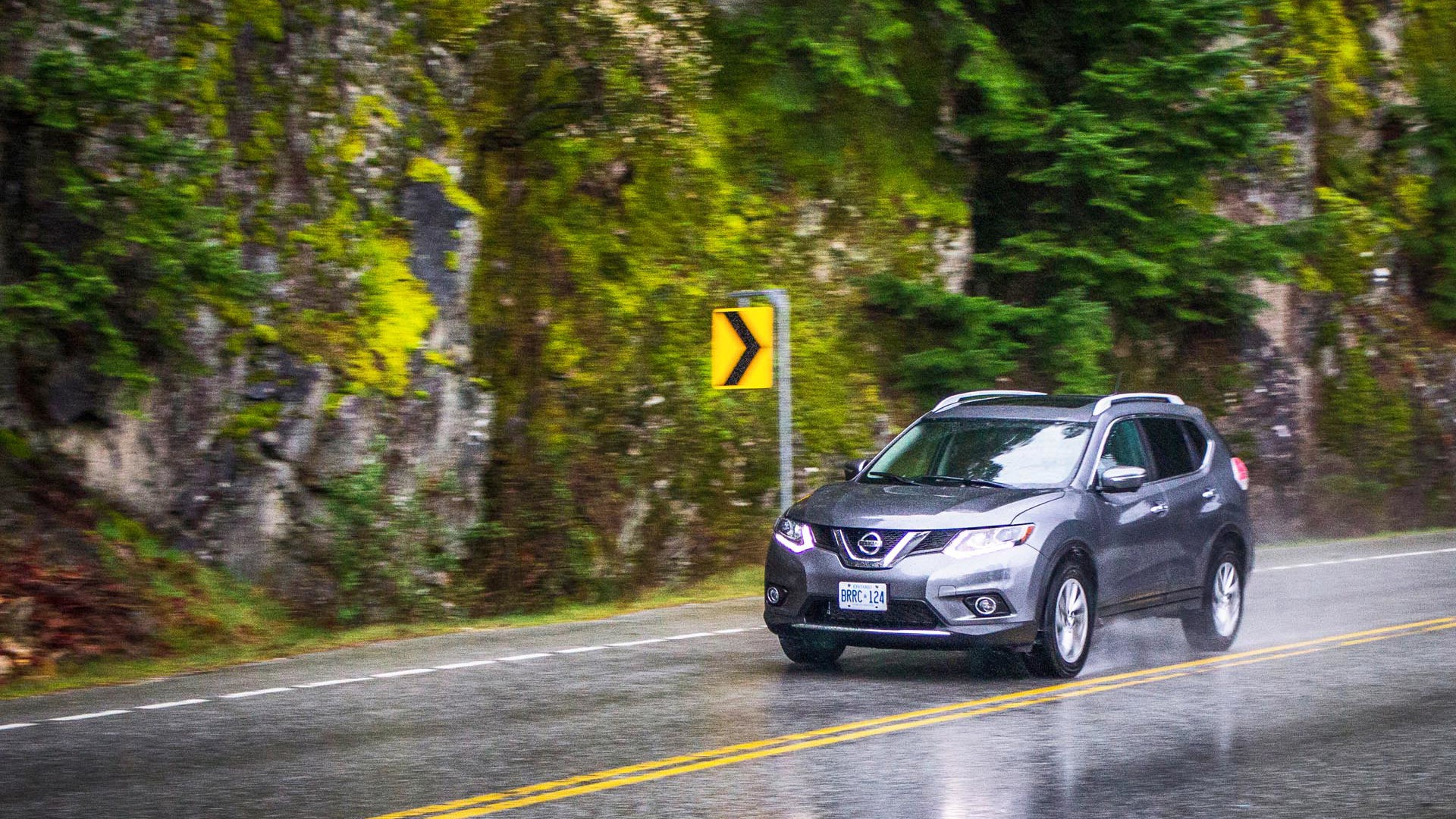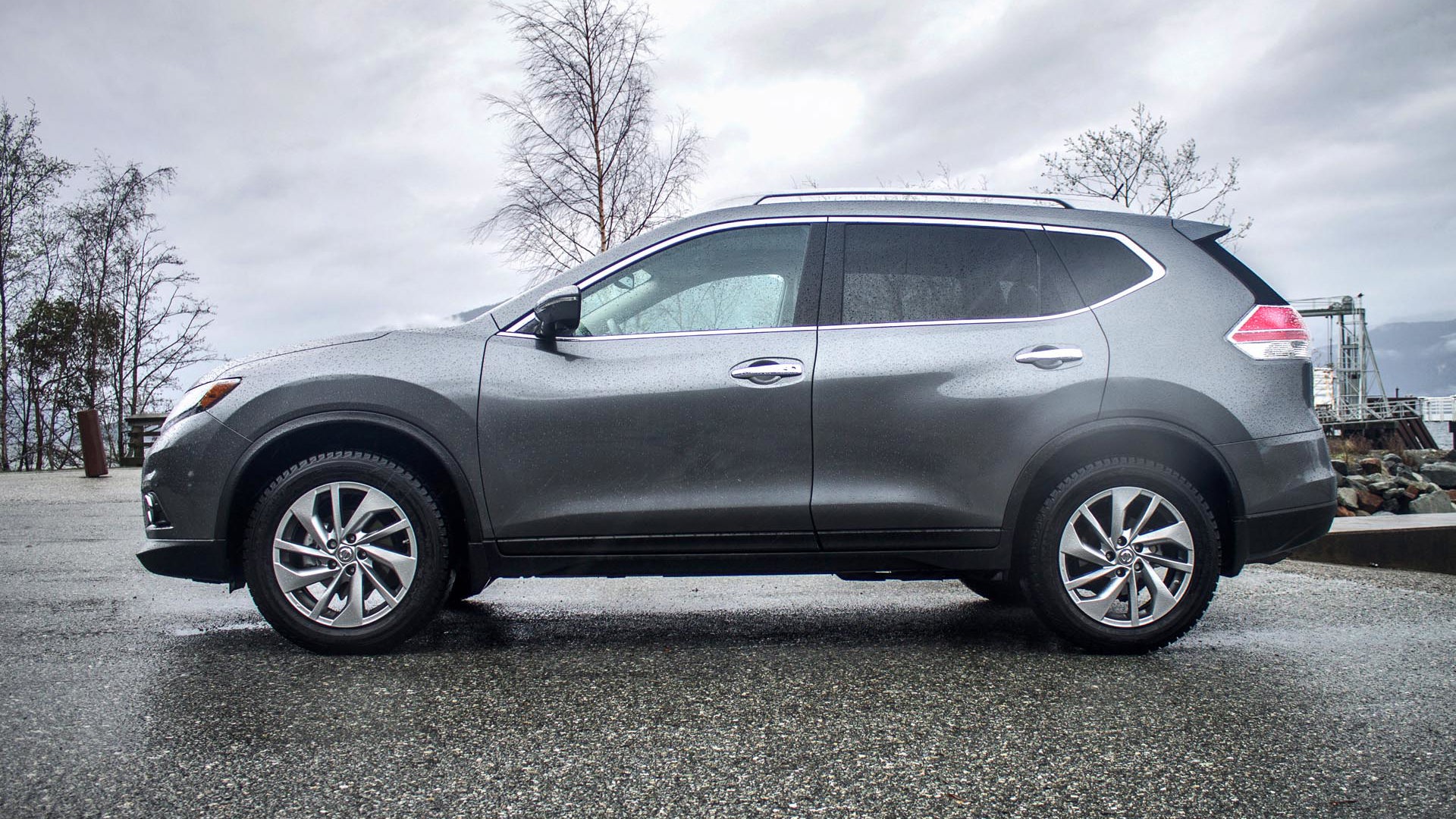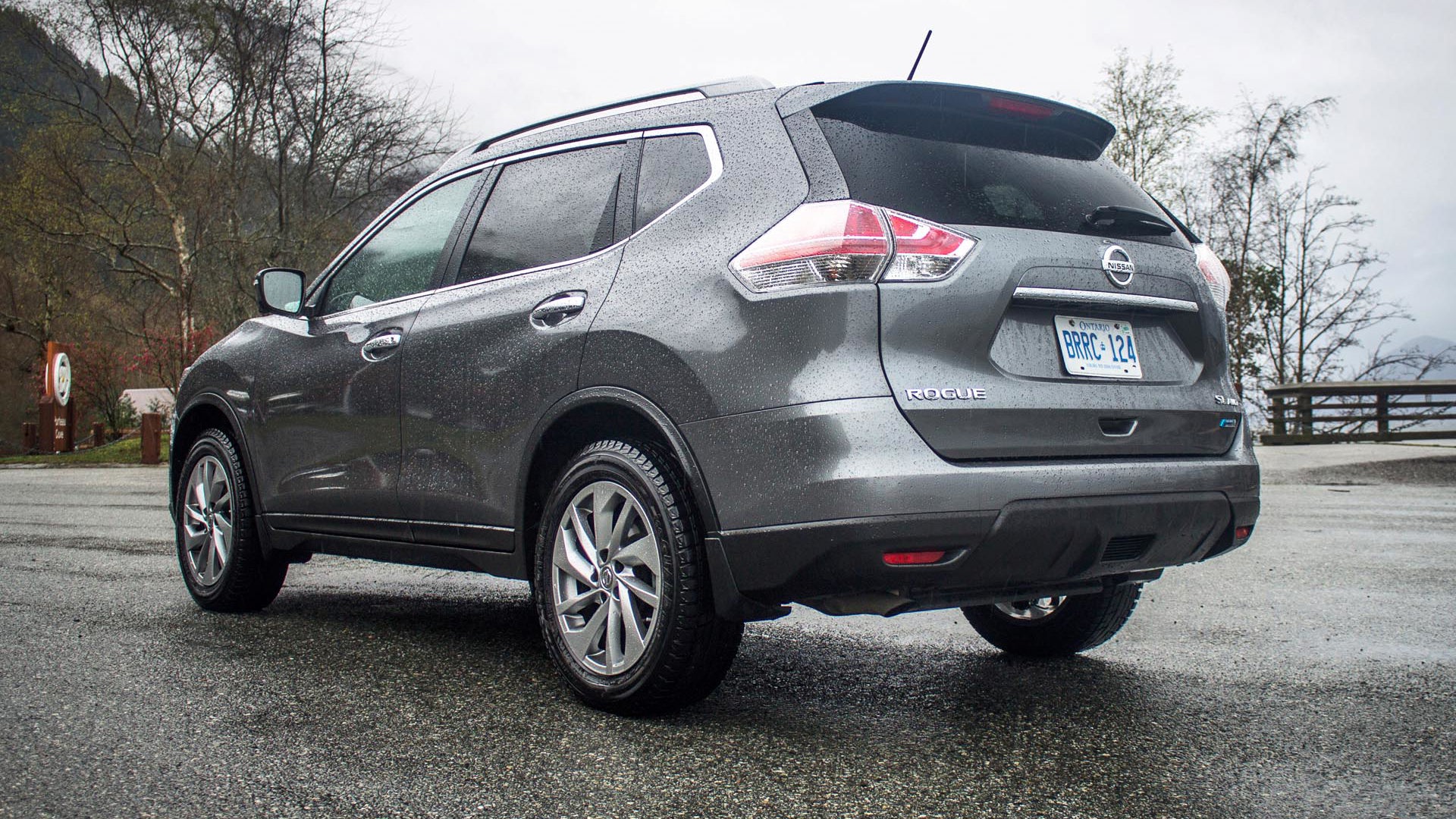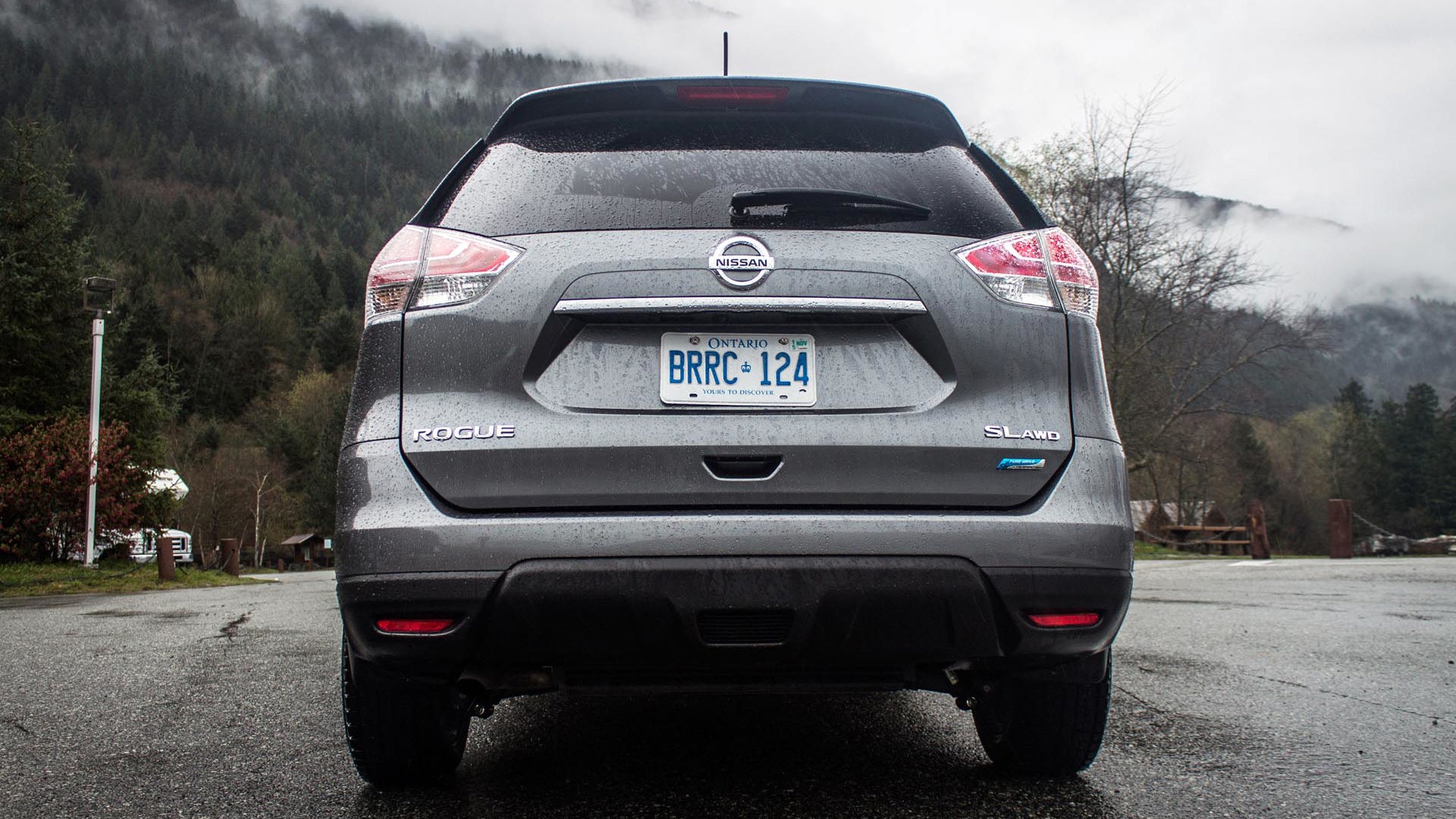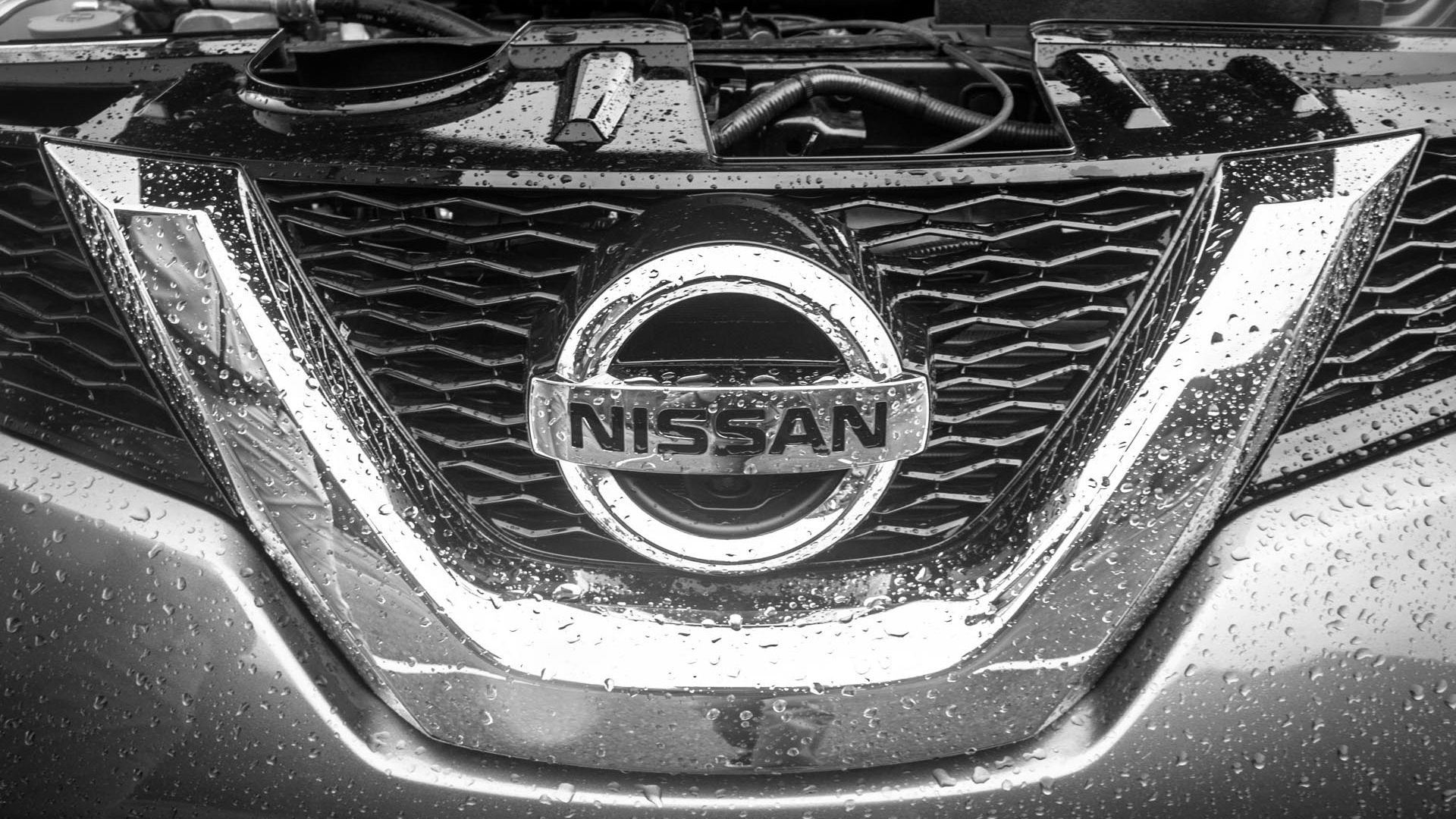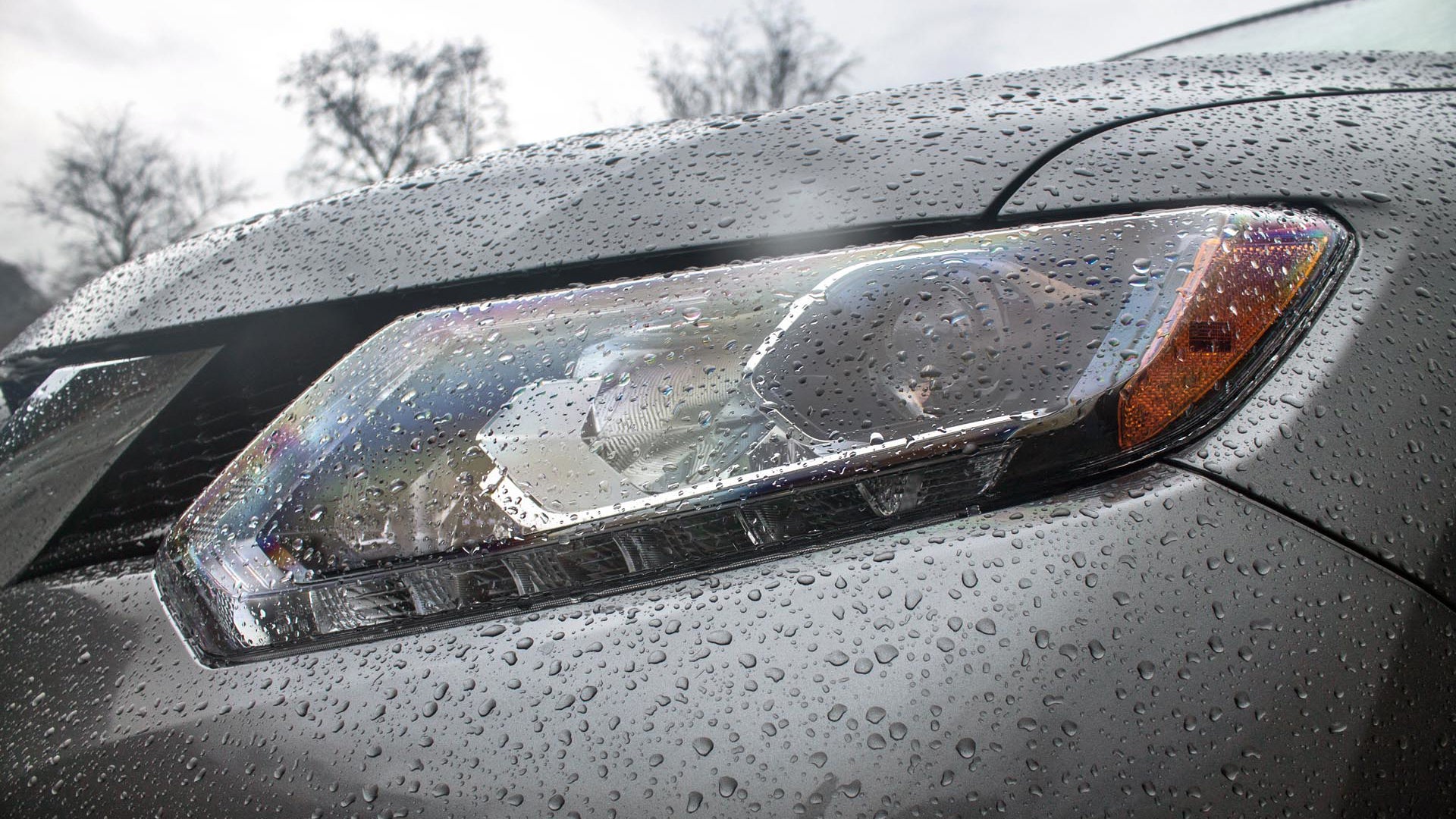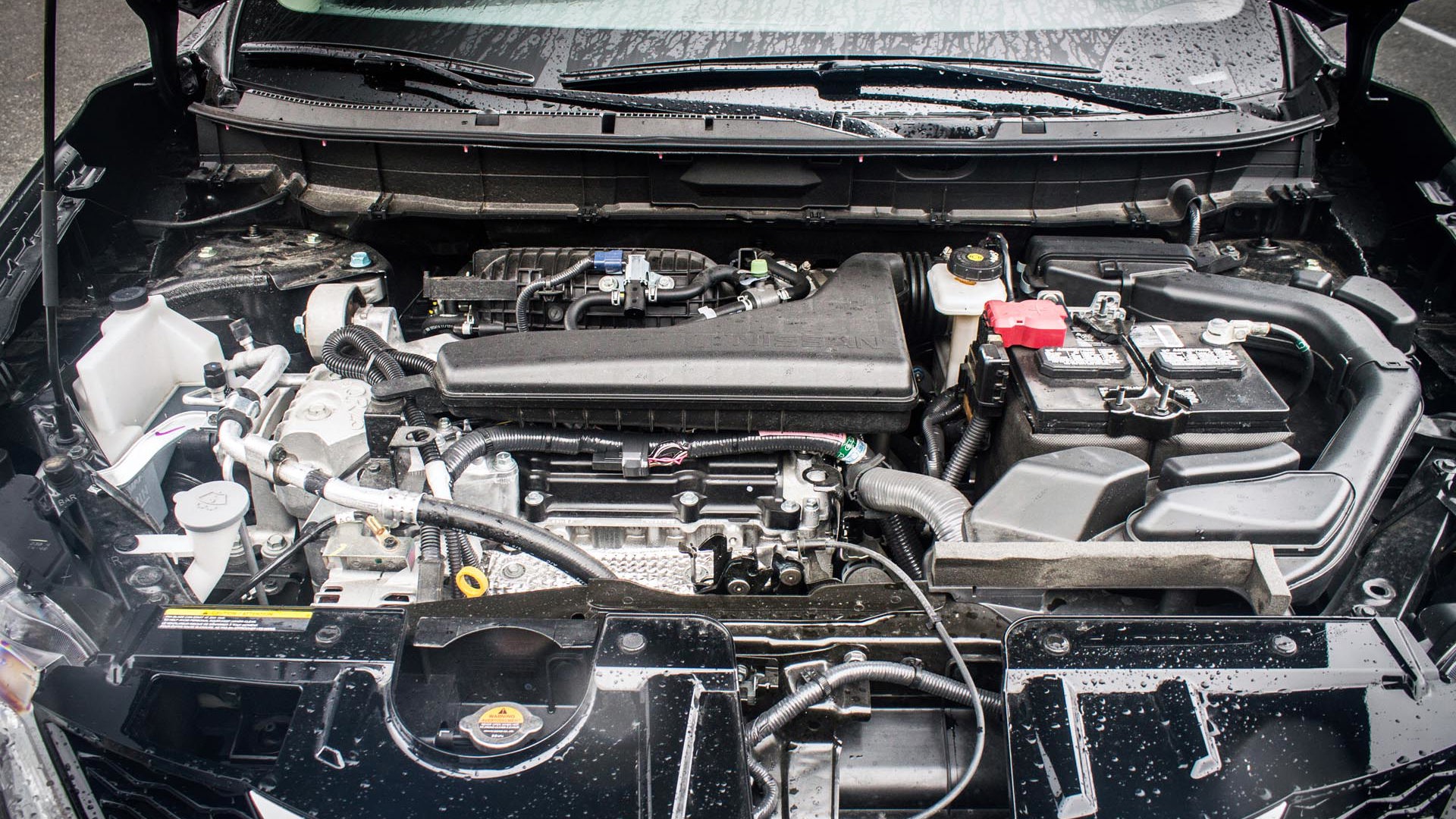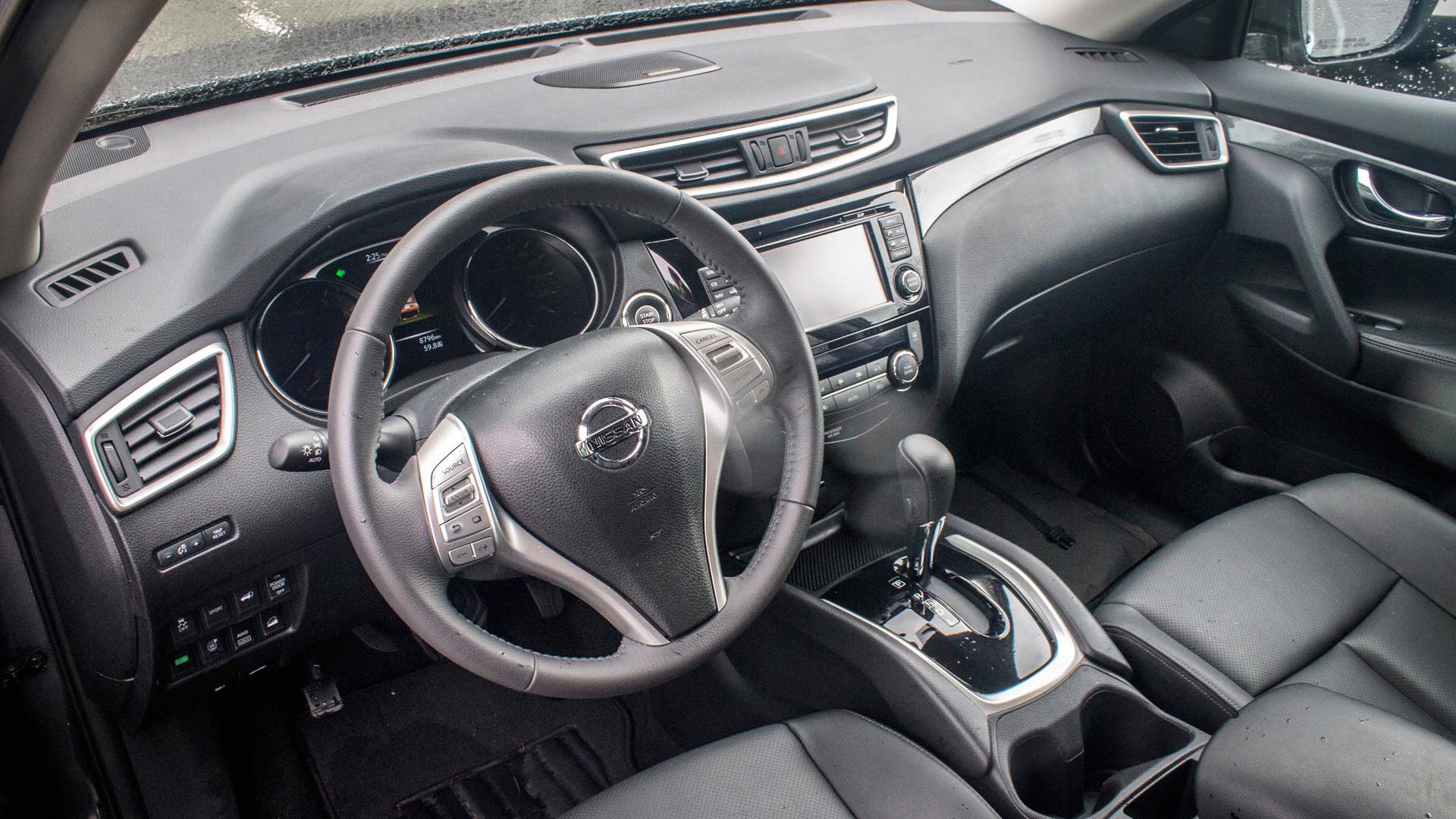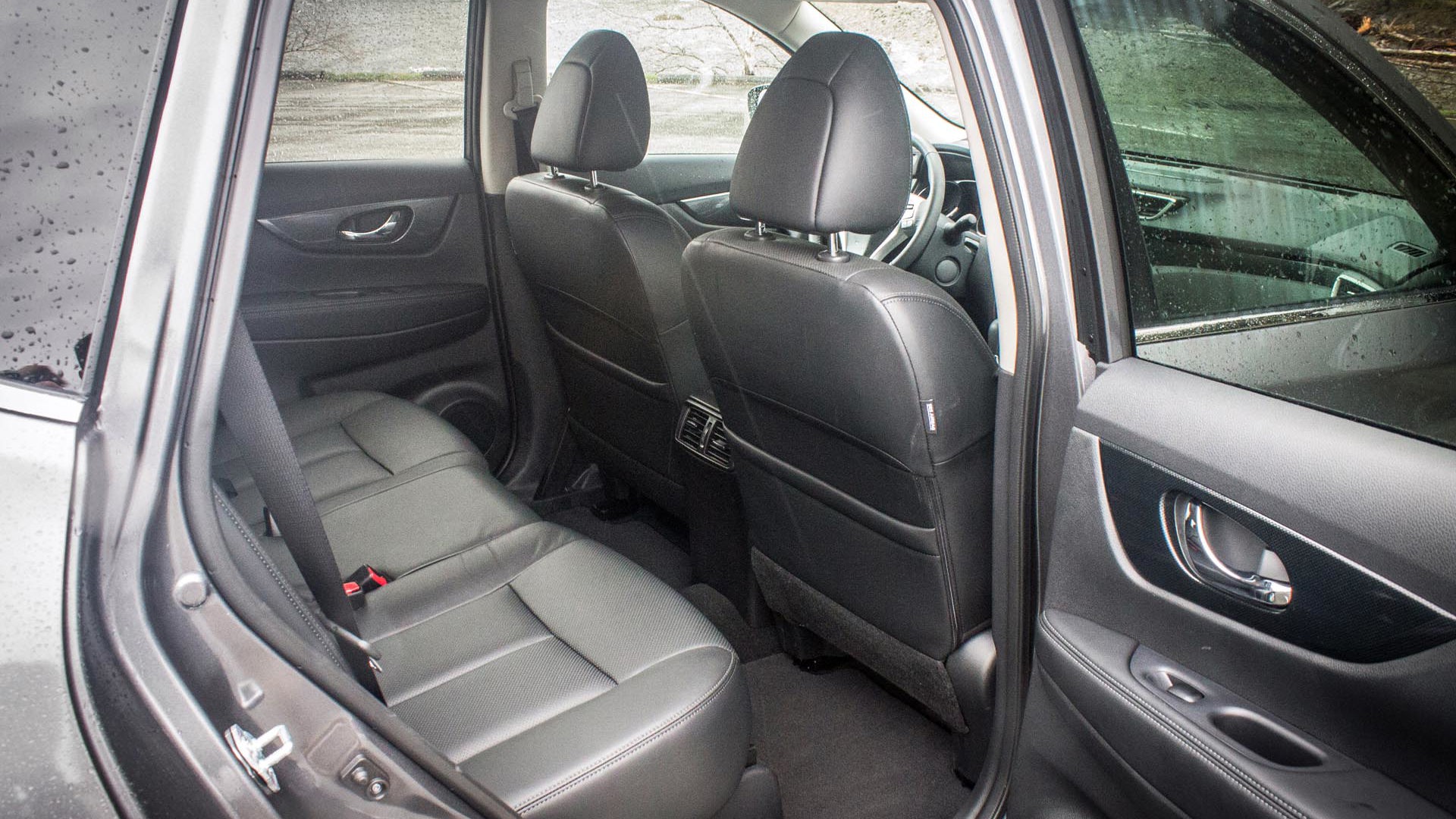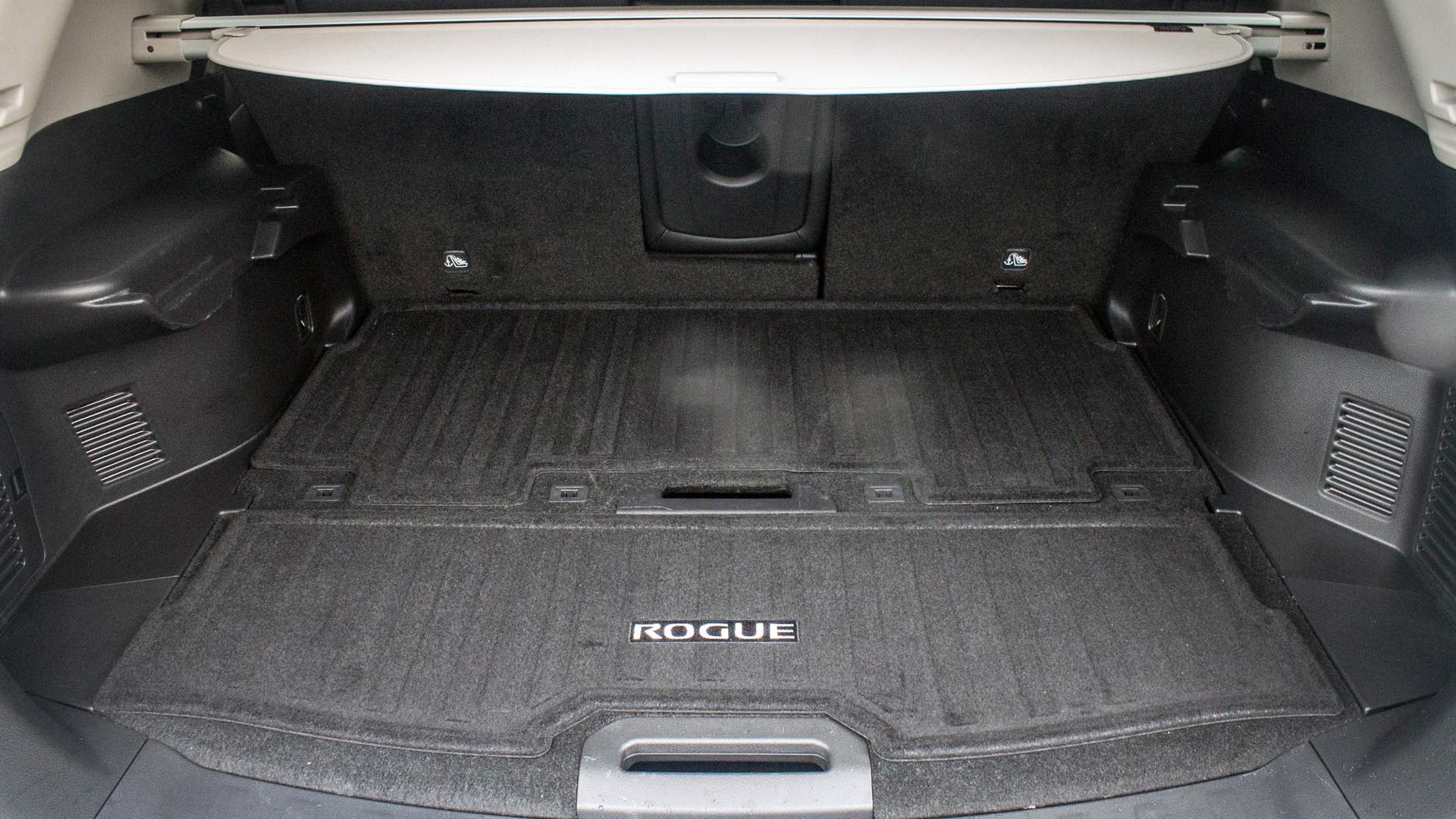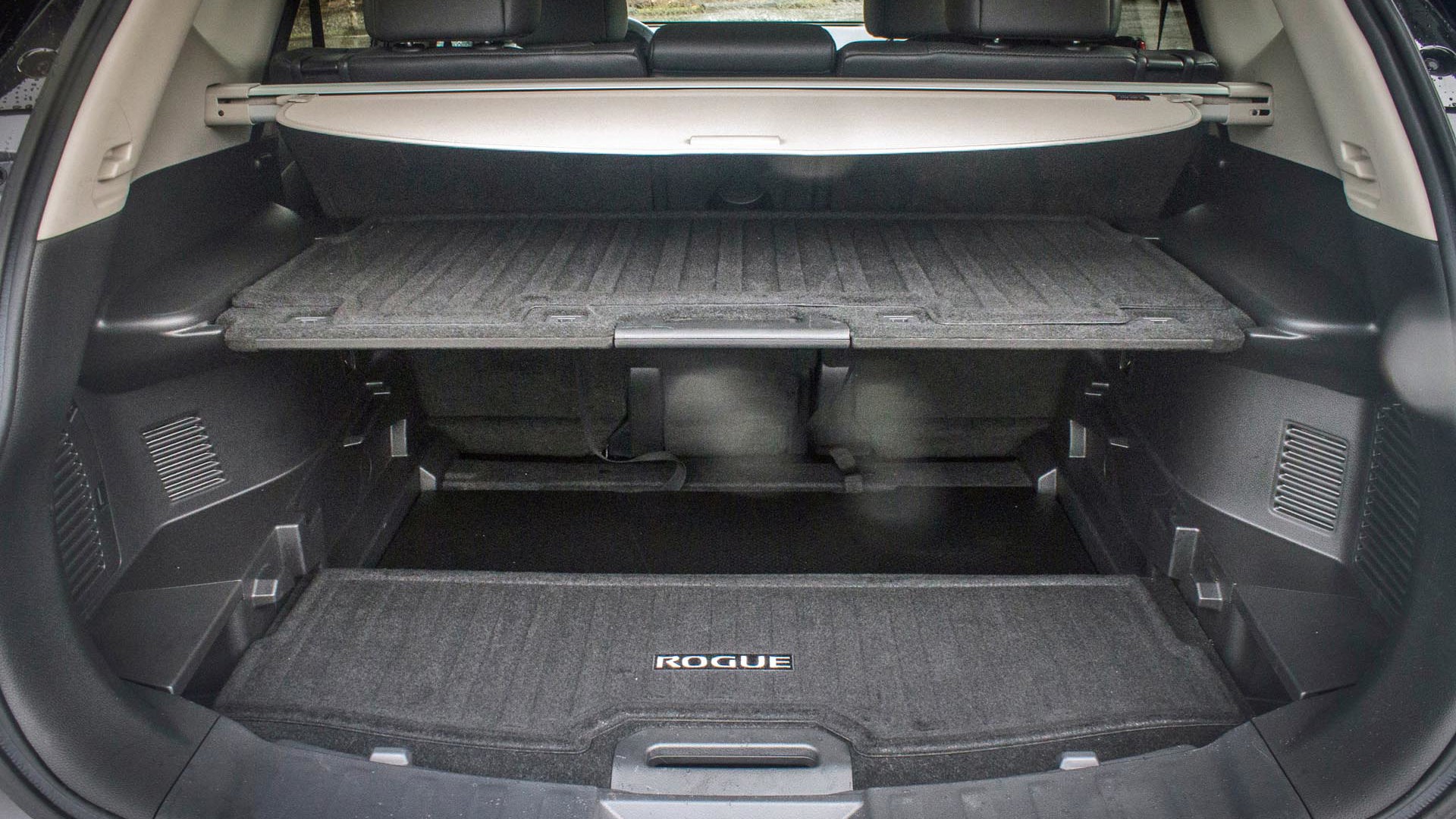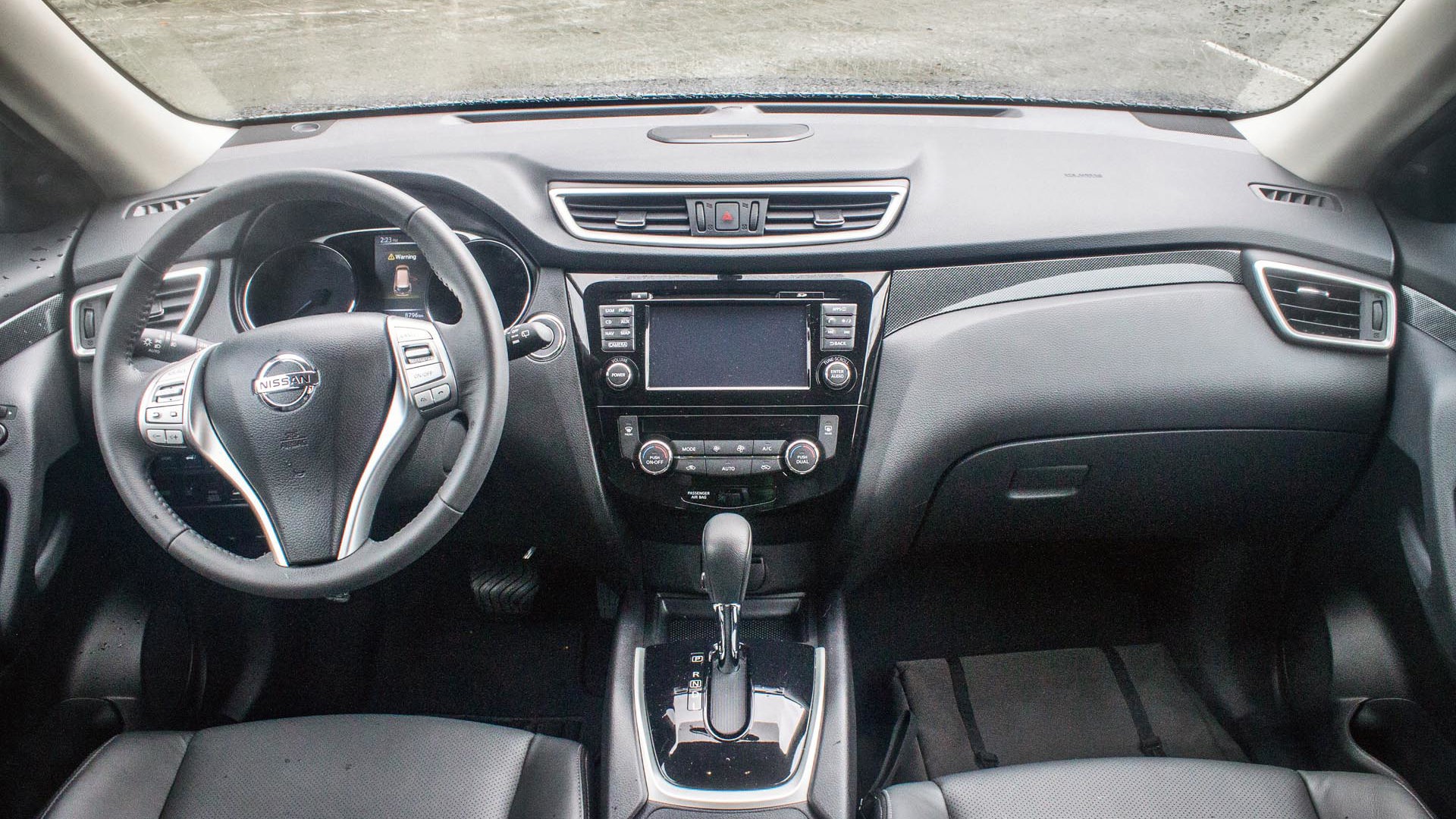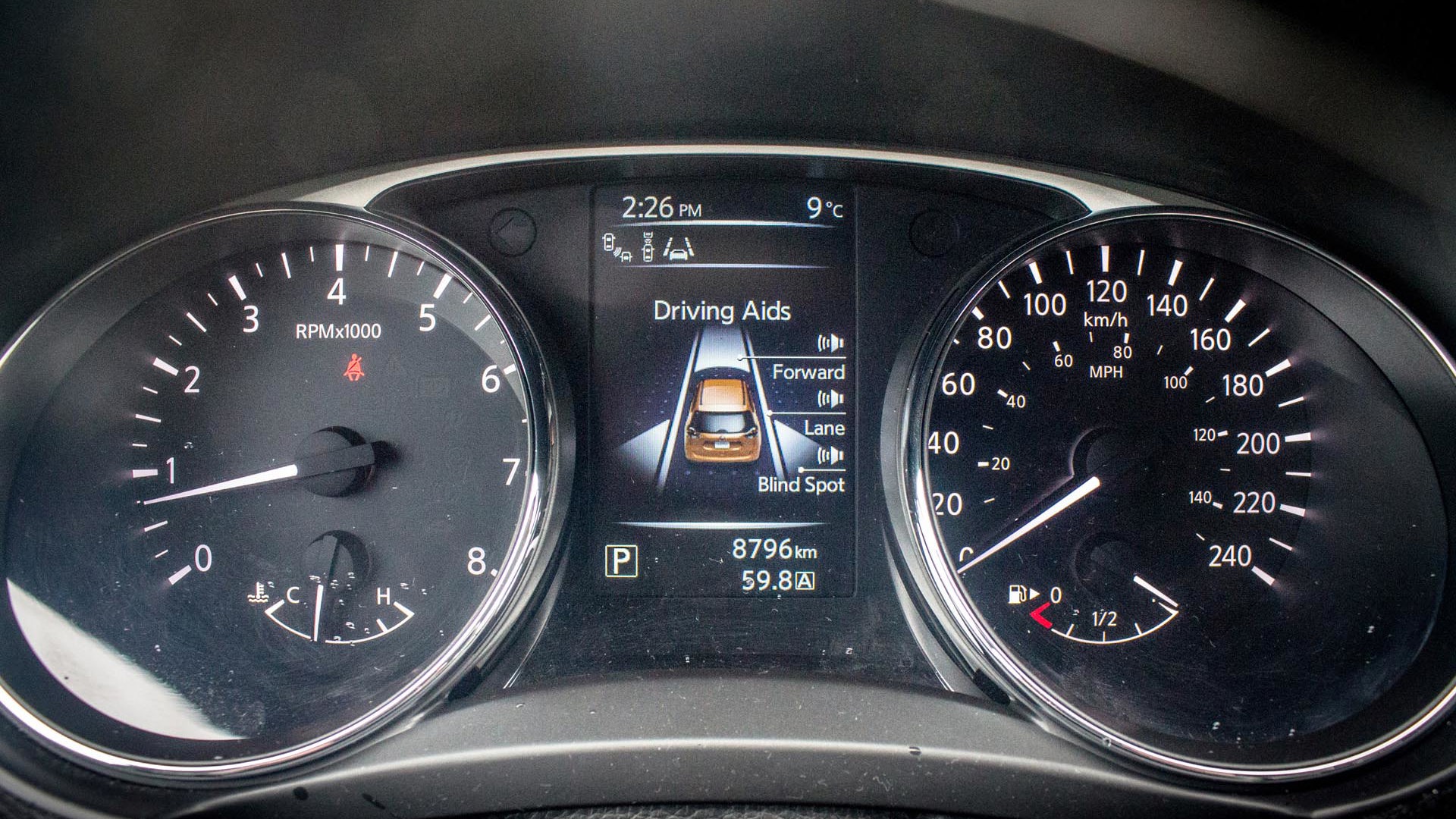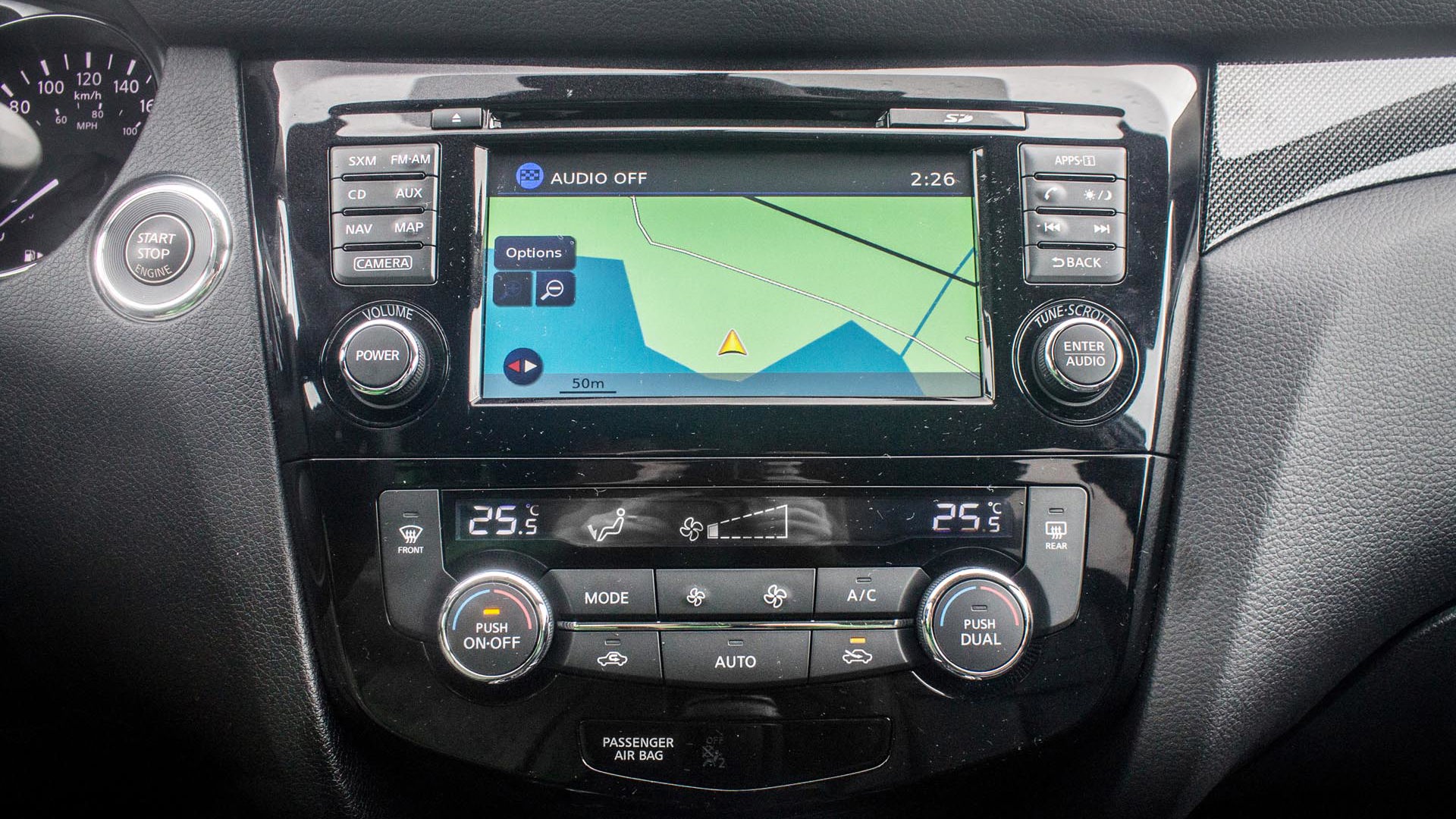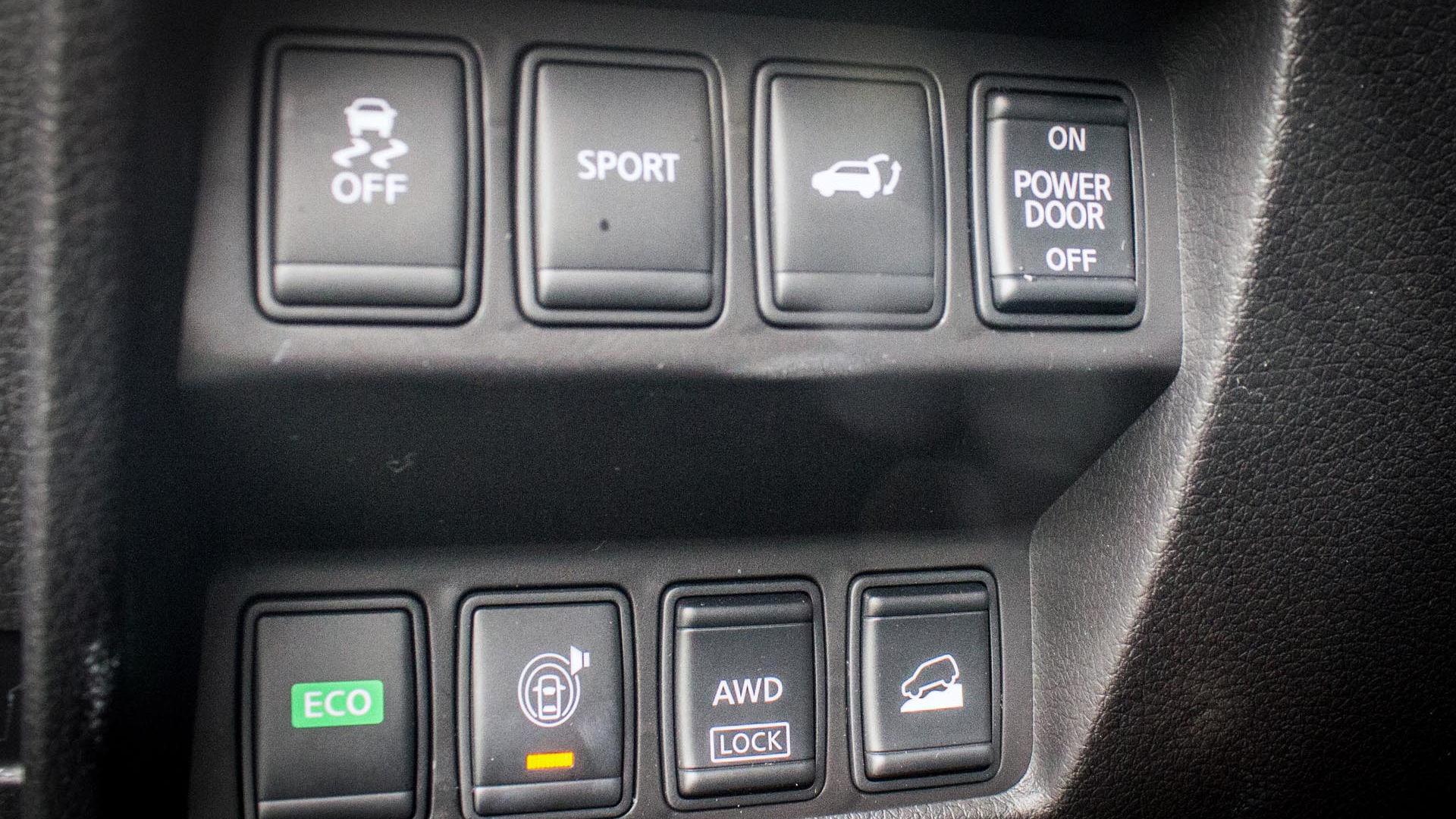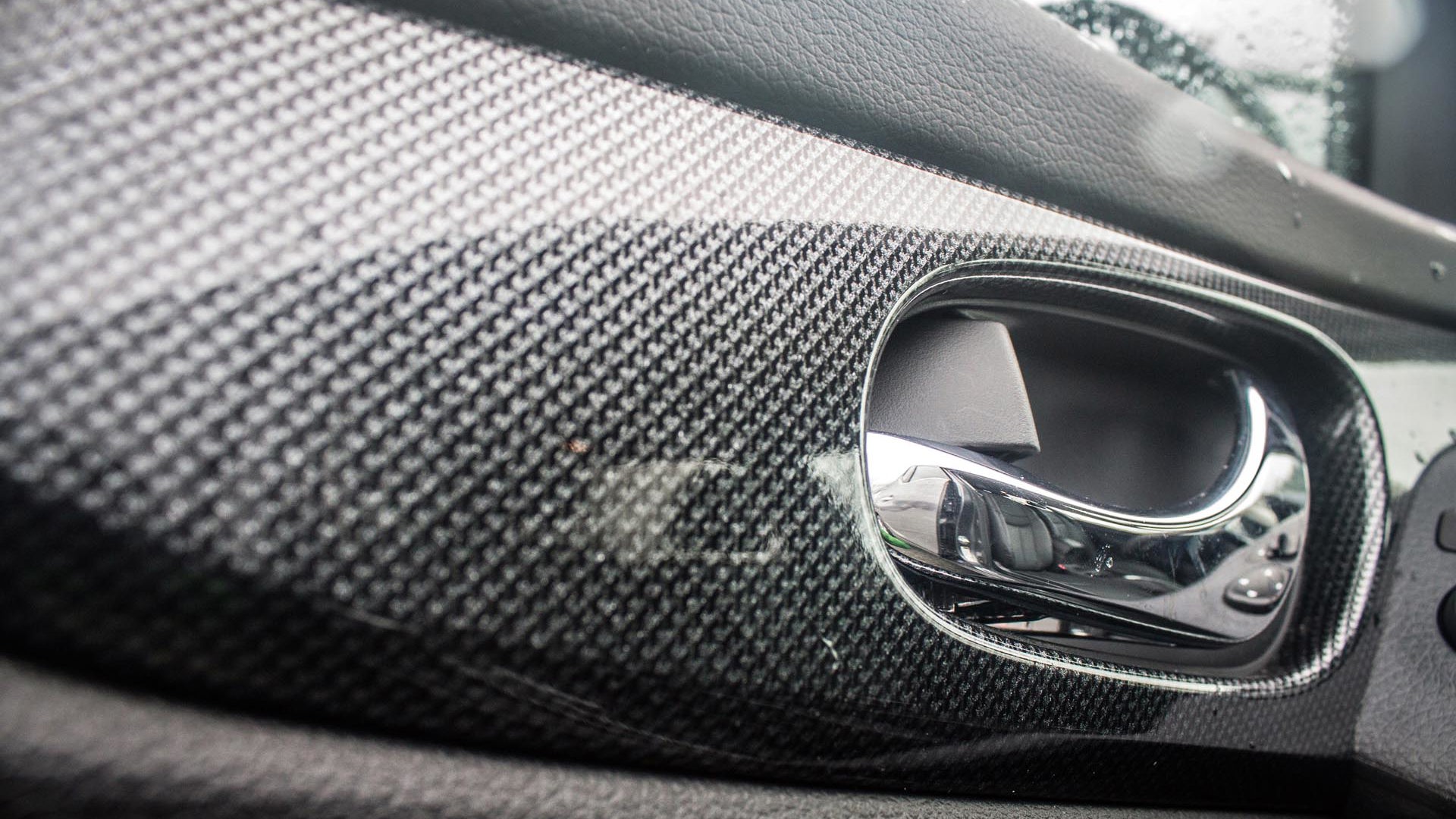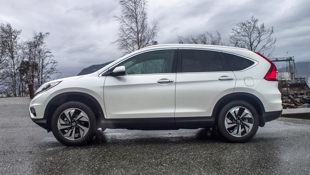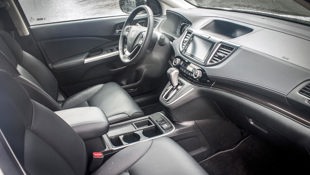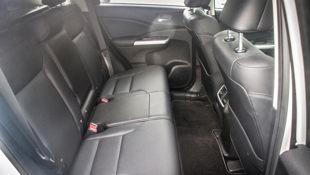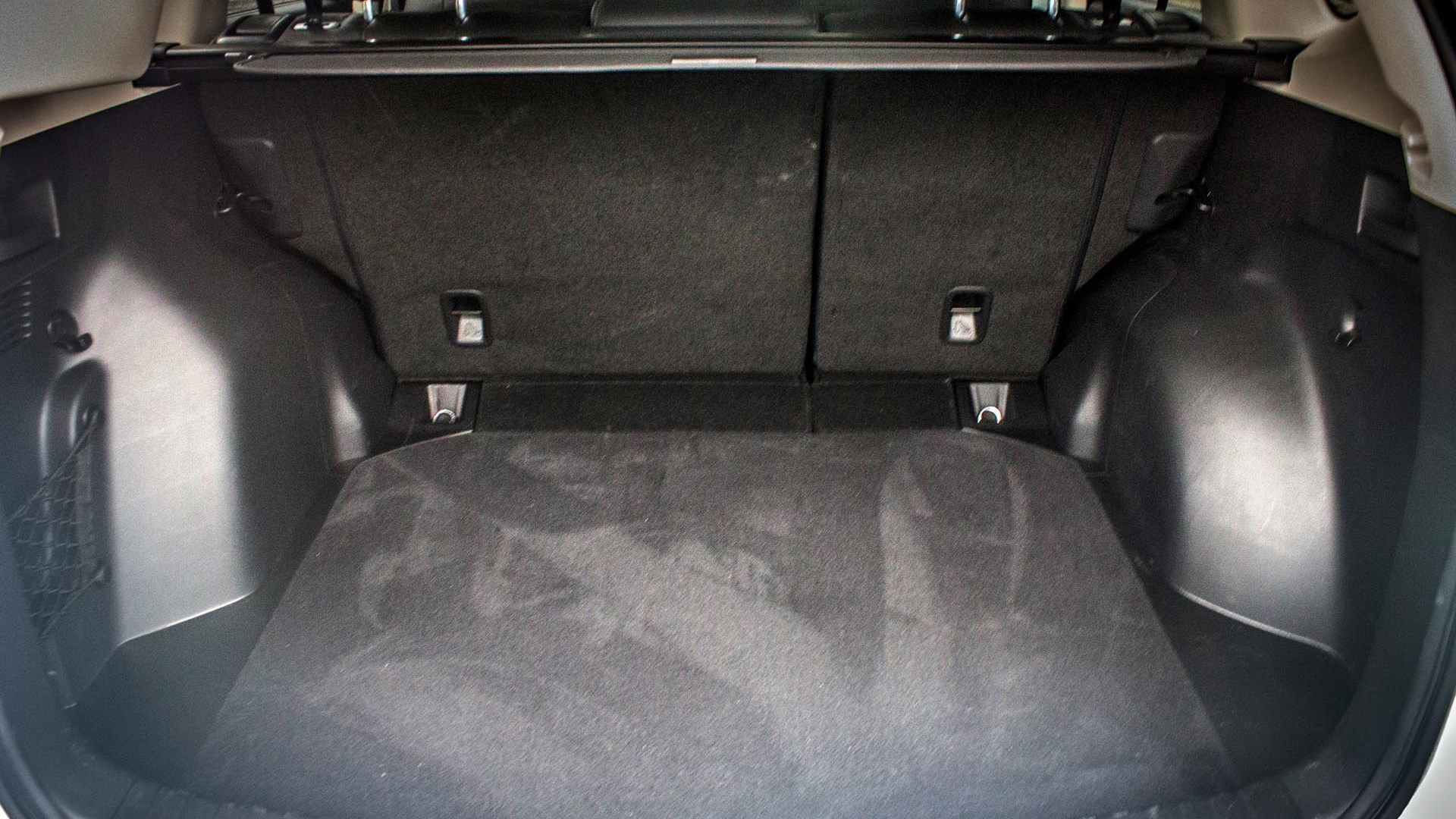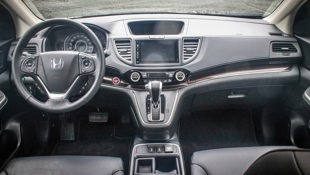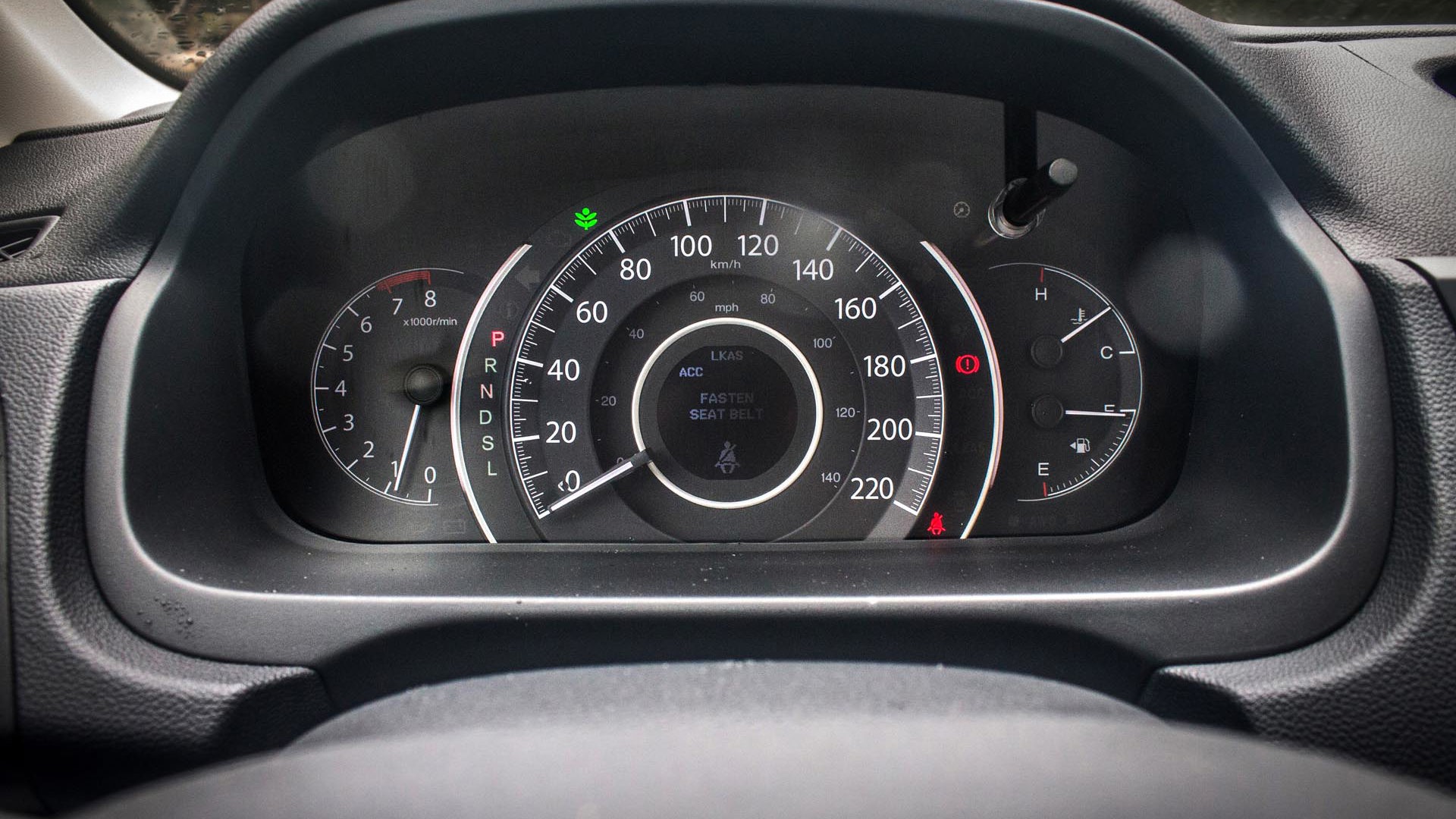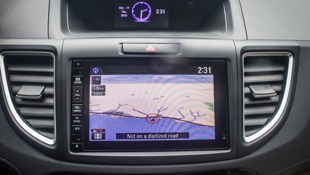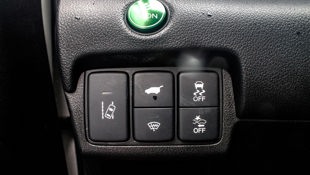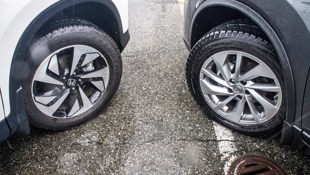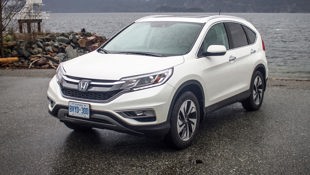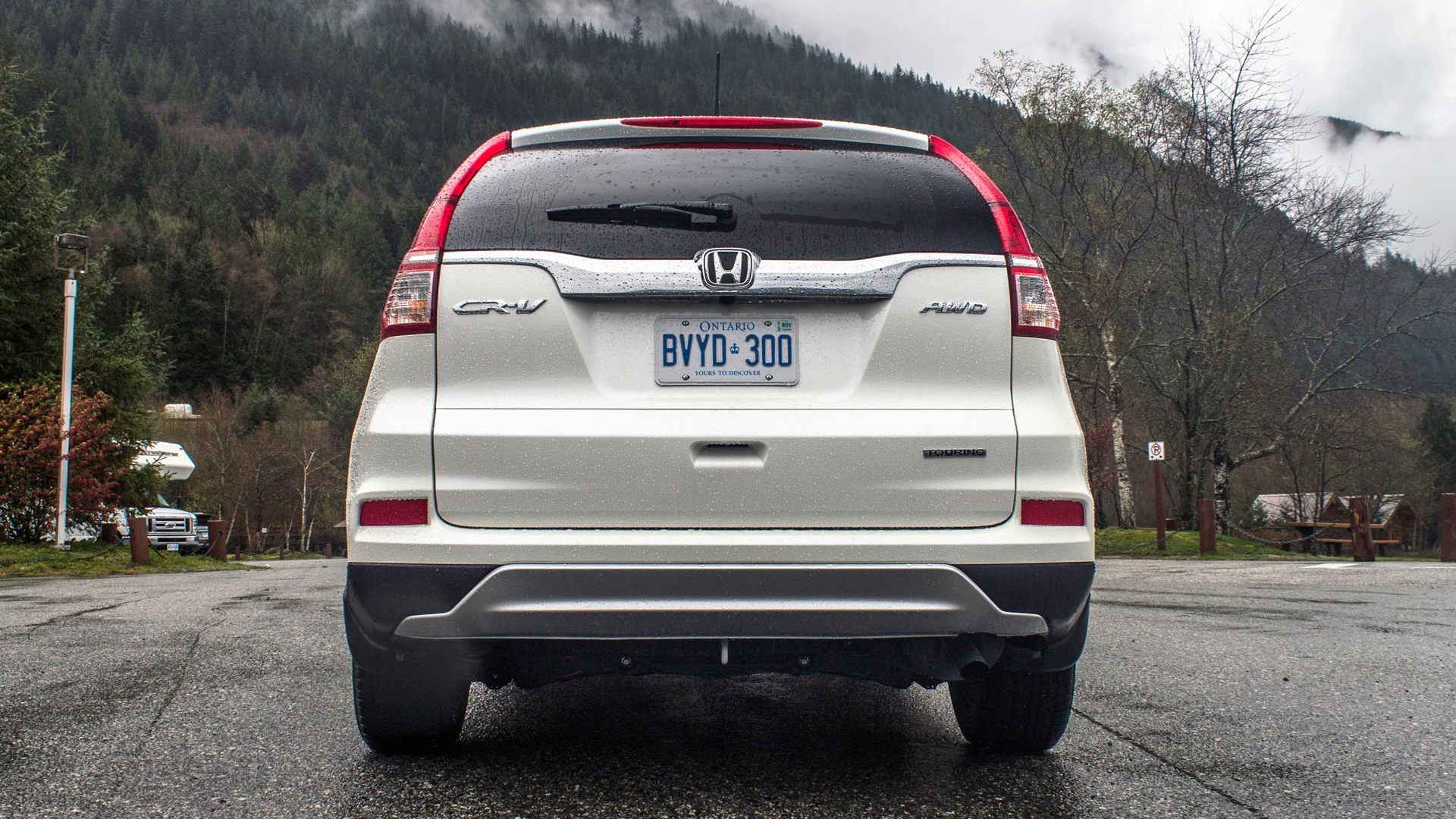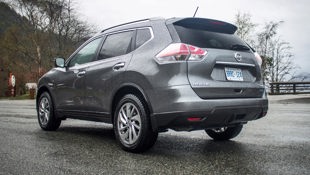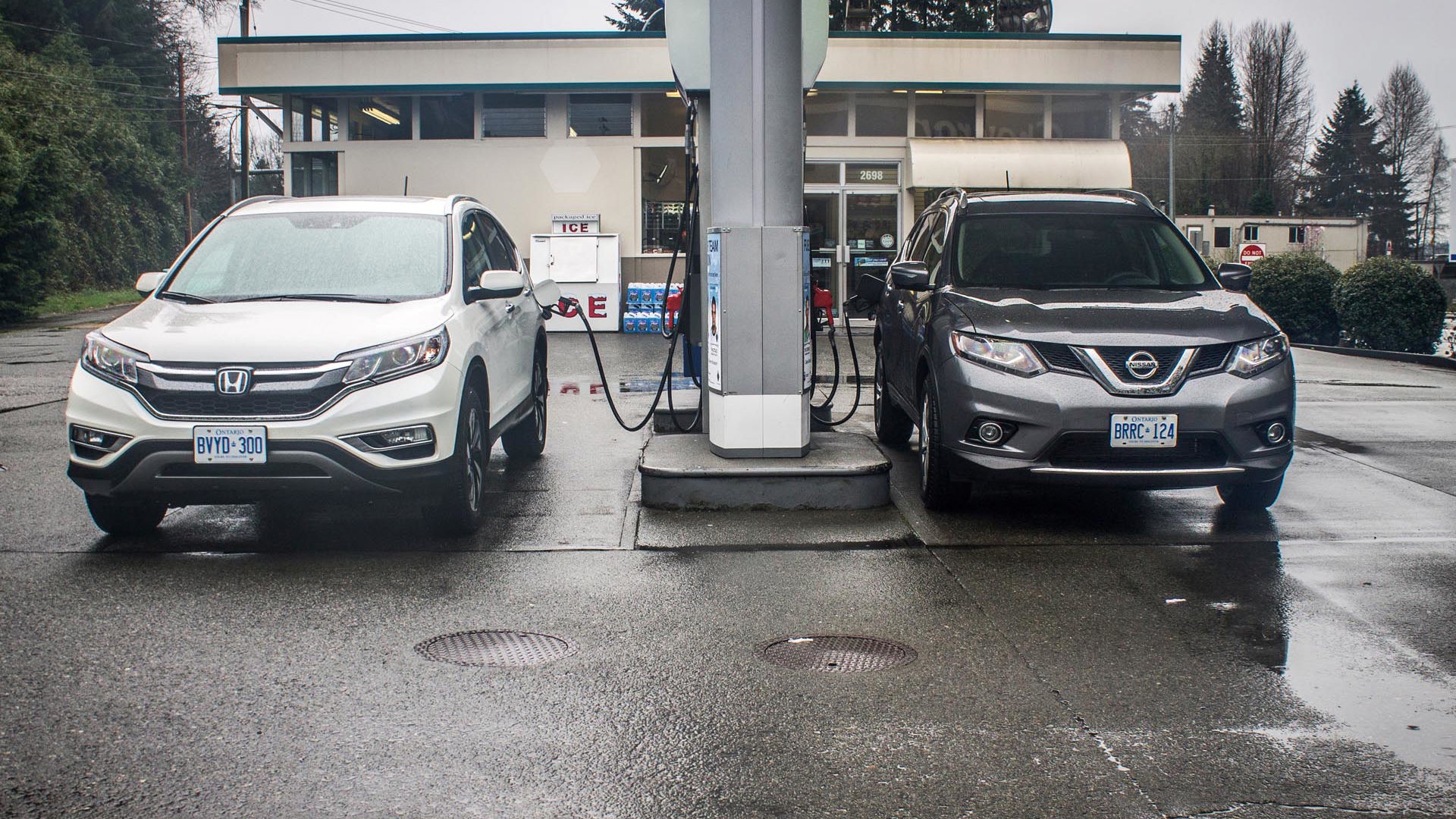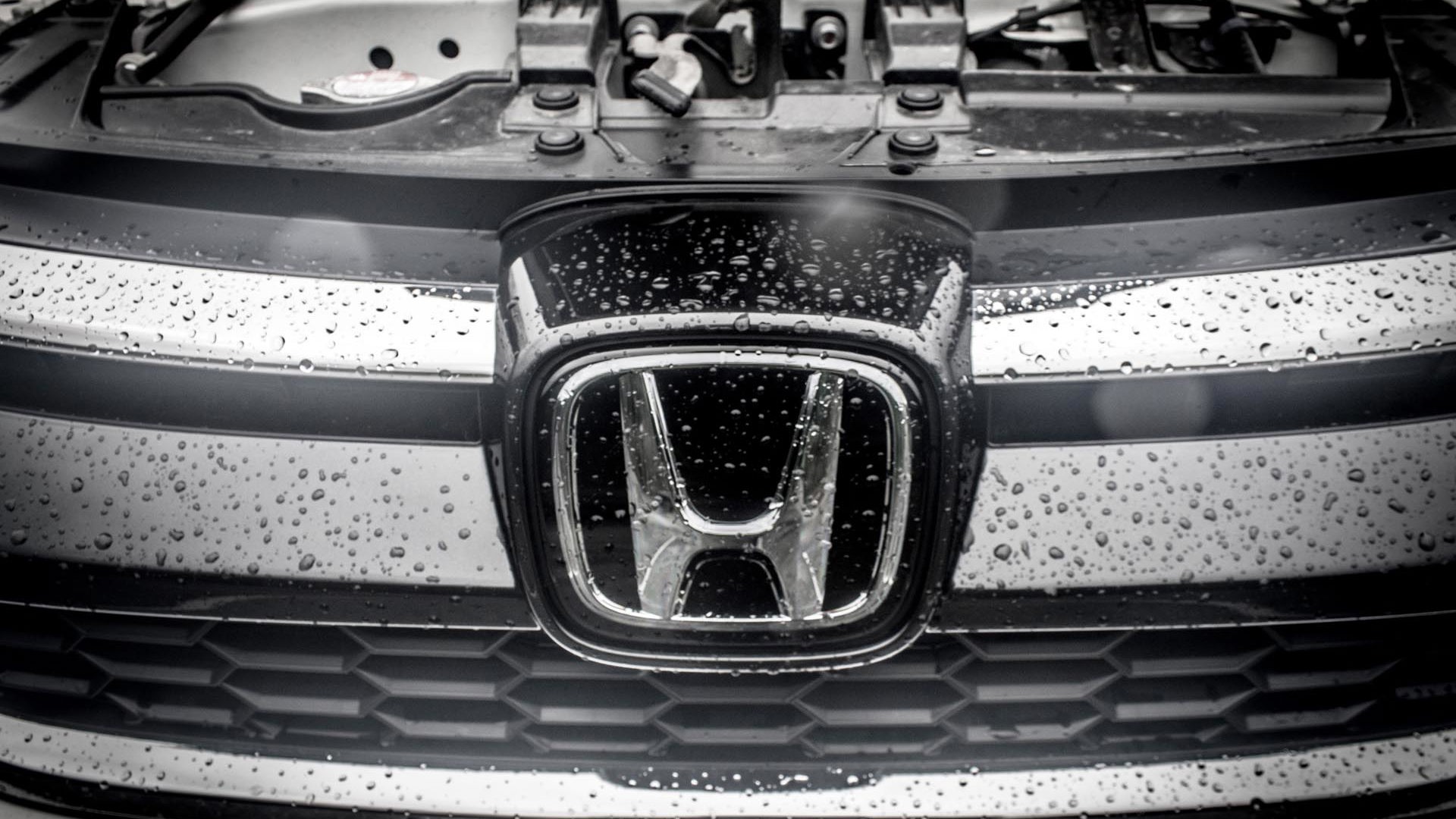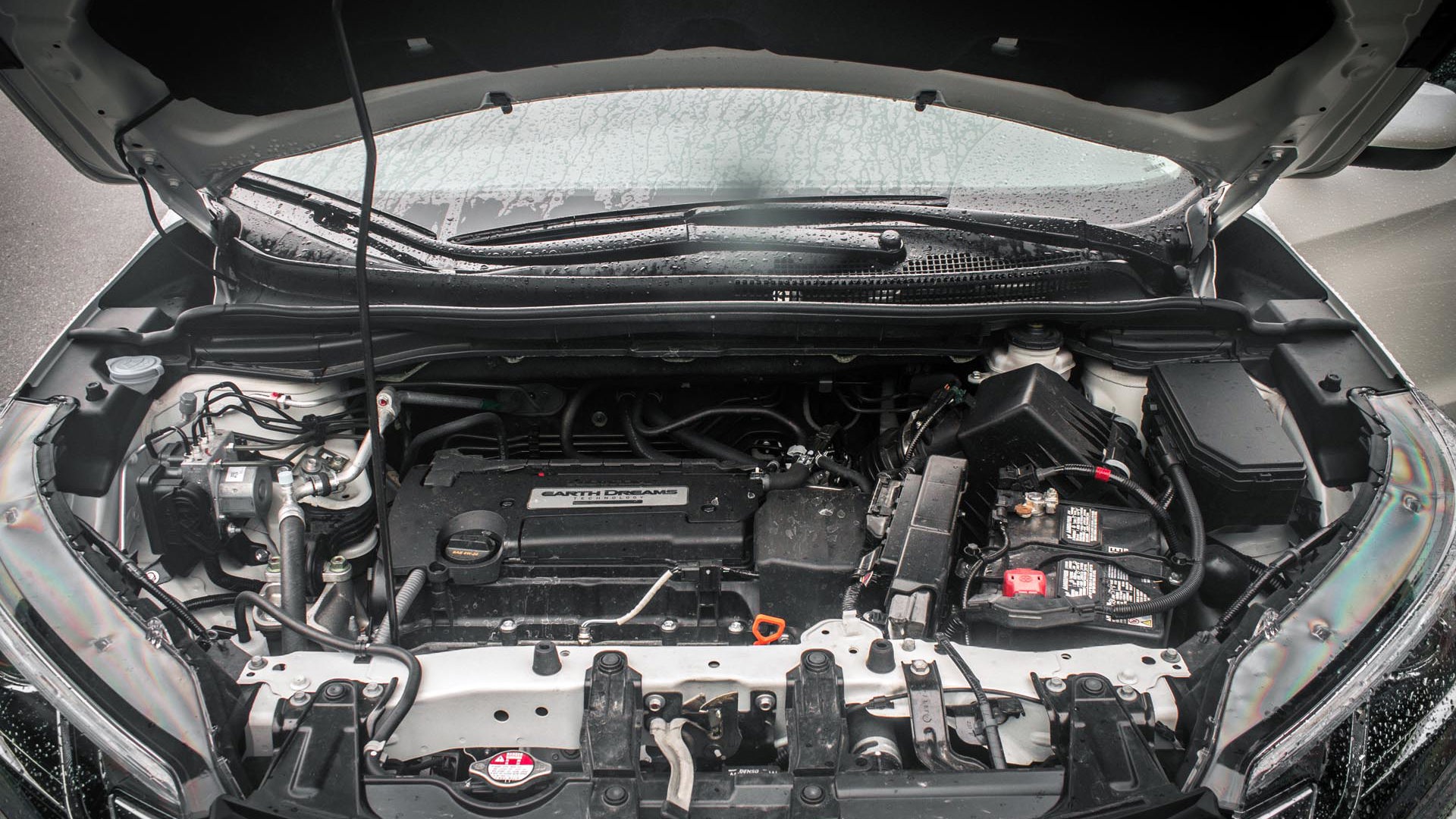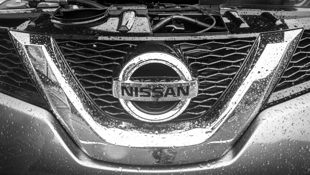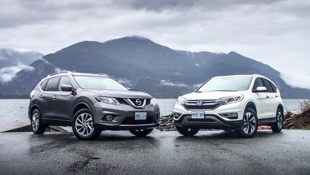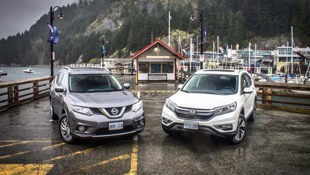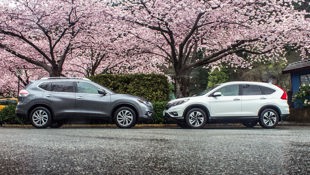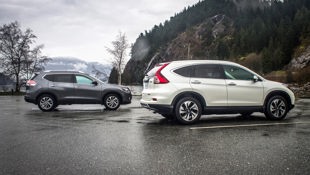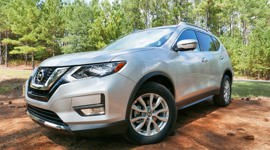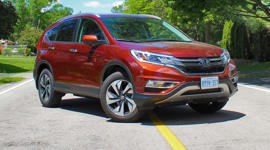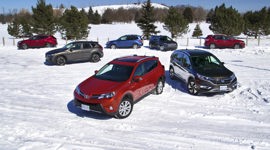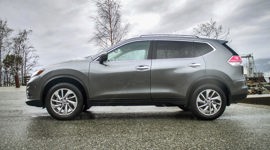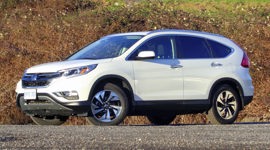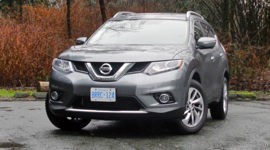Comparison Data
|
Base Price
$36,540
|
$31,298
|
|---|---|
|
Optional Equipment
None
|
Premium Package – $2,800 (LED Headlights with auto-levelling, power slide/recline front passenger seat, power liftgate, welcome lighting, four-way power front passenger seat, Bose audio w/nine speakers and two subwoofers, radio data system, speed-sensitive volume control, Nissan Navigation System, Srius XM w/traffic, Around View monitor, blind spot warning, lane departure warning, moving object detection, forward collision warning); Metallic/Pearl paint – $135
|
|
A/C Tax
$100
|
$100
|
|
Destination Fee
$1,695
|
$1,750
|
|
Price as Tested
$38,335
|
$36,083
|
Review and photos by Dan Heyman and Brendan McAleer
Cue the Gene Kelly impersonations and let's start slinging these two in the rain.
(Brendan says)
Dan and I are rain gods. This is somewhat inconvenient.
I ain't joking: in every single one of our past four or five comparison tests, as soon as we grab the keys, the heavens grumble, the clouds gather, and the heavy sheeting rain begins. If I were a member of the California Board of Resources, I would immediately ask the two of us to schedule a convertible shoot out in Los Angeles ASAP. We'd end the drought in about two hours.
However, while a rainy day isn't convenient for photography and tends to snarl traffic up somewhat, it does provide a good backdrop for some real-world testing. What's more, the two crossovers we have here today aren't just about sunny days – these are the sort of vehicles that have more or less replaced the four-door sedan as the mainstay of Canadian families. They have to be good when Mr. Golden Sun refuses to come out, no matter how much Raffi begs him to.
The Nissan Rogue and the Honda CR-V were the top two finishers in autoTRADER.ca’s seven-car crossover shootout, which exposed them to a traditional Eastern Canada winter landscape. Here on the soggy West Coast, Lord Poseidon and I are going to referee a rematch. Well, we won't be able to separate 'em much on looks – the CR-V's front lights appear better than the Rogue's dotty LEDs, but neither one of us liked the Honda's slightly hunchbacked three-quarter view.
Let's let the styling critique run down the drain with the rest of the rainwater. Cue the Gene Kelly impersonations and let's start slinging these two in the rain.
Ride, Performance, and Handling
(Dan says)
Honda makes good driver’s cars—it’s been said many, many times both in the annals of this site and the car journalism catalogue as a whole. They put a focus on making good driver’s cars out of the lowliest hatchbacks, and we love them for that.
Still, I was surprised to find the same feelings of connectivity between driver and car as I did in the CR-V.
You sit a little higher in the CR-V than you do the Rogue, actually, but after that, the way the just-right-sized wheel falls into your hands and the way the gear lever protrudes from the centre console—Civic SiR style—is just right.
Then, as you begin to proceed (in either “D”, “S” or “L”; I was happy to find the CR-V’s CVT transmission has all three, where the Rogue just gets “D” and “L”), the fantastic linearity of the drive experience makes itself felt pretty quickly.
That nicely sized wheel I talked about? Well, it connects you to a wonderfully responsive steering rack. Indeed, some drivers may find it almost a little too lively—almost nervous—but I’ll take that over a mushy, overly assisted power steering setup any day of the week.
For its part, though, the Rogue does hold its own. Yes, it doesn’t feel quite as granular as the CR-V does, but the 170-hp, 175 lb-ft four banger (the Honda makes 185 and 181, respectively) does well enough to perform passing maneuvers at highway speeds with little concern. Thankfully, while not quite as lively as that which is found in the CR-V, the Rogue’s CVT doesn’t apply the shackles too heavily to the powertrain.
After that, we move on to one of the true strengths of the Rogue, and that’s the ride. Actually, it’s the ride and passenger comfort in general; in the comfort department, you get the NASA-developed Zero Gravity seats, designed to better focus on back and hip support. The Honda’s seats are quite firm by comparison, and almost hard. What the Rogue gives up to the CR-V in handling, it earns back in overall ride quality, which is just a little less brittle, a little more confidence-inspiring than the CR-V.
If you do want a little more “sport” to go with you “utility”, then go ahead and select “S” on the CR-V’s gate. It allows the transmission to hang on to revs a little longer, and is more ready to “shift down” (basically selecting a lower virtual ratio, as there are no gears to shift between in a CVT). There’s also “L” in each car for better performance when climbing hills or in adverse conditions. It’s the Honda that comes closest to making you forget that you’re driving a CVT at all. The larger power figures help here, too.
Comfort and Utility
(Brendan says)
It doesn't take an expertly trained posterior to feel the difference between these two. In fact, I could probably pick these out blindfolded, like a sommelier sniffing out the difference between Cab and Merlot. Er, except using my other end.
The Rogue is the comfort champion here – love at first sit. The so-called Zero Gravity seats are genuinely comfortable, and you feel as if you're sitting in them, rather than atop them. The Honda's seats aren't exactly church pews, but they're much harder, and perhaps a little short in the bottom cushion. We will award some points back to Honda for the memory positions on the driver's side, but if long trips are going to be part of daily life, the Nissan is just better.
Utility is more of a mixed bag, with the CR-V the leader here. Its trunk is uncluttered and spacious, and if you own a dog, the low loading height will be a boon, particularly as Fido begins advancing in years. The Honda's trick folding seats again beg the question, “Why isn't everyone copying these guys?”
In many ways, the differences between the cars feels like that between the old Versa and the Fit, where the Honda had practicality cornered, and the Nissan offered French levels of comfort, perhaps as a result of their relationship with Renault.
However, the Rogue has several tricks out back, including a folding multi-level floor that would be especially useful for young families. The two-level split makes separate spaces for strollers and for other gear, so that frequently unloading larger items doesn't mean unpacking everything from the trunk. Also, the Rogue has a pass-through for its folding seats, so while the Honda's rear seats are more clever, the Rogue does offer some additional flexibility.
Perhaps the biggest surprise came when it was time to fit a child seat in the back of each car. I brought along the Diono rear-facing seat I currently swap in and out of all kinds of press cars, and had the grand idea that perhaps Dan should time me to see which vehicle proved the easiest. We started with the Rogue, and after two full minutes of cursing, we called it. There's a design flaw here in the Nissan, one that makes quick release attachments an absolute bear.
The problem seems to be that the LATCH anchors into which the car seat is meant to clip have a fair amount of fabric right up to the ends. The Diono's clasps wouldn't click, although I was eventually able to wriggle one into place once I figured out what the issue was. If you're considering a Rogue, make sure you test fit your car seat to see if a similar issue arises. The CR-V had no such problems, and the seat was properly installed in under thirty seconds.
Technology
(Dan says)
When it comes to comparing the pros and cons of each vehicle, it doesn’t get much easier than this.
The infotainment system found in the CR-V is the perfect example of too much tech for the sake of it. It’s mainly a touchscreen setup, but unlike the item found in the Honda Fit, there are some redundant buttons on the left-hand side of the screen, but they are so small that they take more than a cursory glance to decipher. And, even when you do locate the button you want, the button is so small that making an accurate press can be a challenge.
The touchscreen itself is large and responsive enough, but again, it takes too long to do anything. Say you’re on the navigation screen, and you want to change your audio source. First, you have to hit the “menu” button (part of the small column of buttons we talked about earlier). Then, you revert to the touchscreen, and select “audio”. Then, after that, you can finally select the audio source you want. The CR-V’s upmarket cousin, the Acura RDX, has a button for AM/FM, and a button for satellite radio, right there on the dash. Why can’t the CR-V have this?
Then, there’s selecting the radio station. There is no tuner wheel, so you have to constantly tap the screen to get there. This is especially aggravating when you’re navigating satellite radio channels because there are so many of them that you end up with callouses on your index finger because you had to press the thing about 40 times to get from “’90s on 9” to “Chill”, on channel 53.
There are a couple of knobs for the climate control system, of which I really am a fan; the frustrating part is, all it would take is two extra buttons and an extra knob to alleviate all these issues.
Take the Rogue, for example. The screen is the same size, and it’s integrated into the centre stack smoothly and in a low-profile way, just like it is in the CR-V. After that, though, what do we have here? Knobs for volume and tuning, buttons for the various sources and for your phone. Thanks for that. Yes, the CR-V does have steering wheel–mounted controls for some of this, but that doesn’t help your passenger at all, and when it comes to navigating XM radio stations, well, I’d say that’s the passenger’s job, should there be one.
Speaking of navigation, you get some similar redundancies with the CR-V in that department, too. Brendan and I did a little Top Gear style challenge, whereby we’d see which one of us – him in the Rogue, myself in the CR-V – could cross town the quickest. The catch (other than having to obey all traffic laws, of course) was that we had to go exactly the way our navi systems would take us, even though each of us know the city well and had our own back-door ways of completing the journey that the navi probably wouldn’t know about.
The challenge would include punching our destination into the system, which, right off the bat, put me at a disadvantage because I was on the “audio” screen at the time and had to make my way, three button presses later, to the “enter destination” screen. Voice commands didn’t really help.
Then, when we got near our destination, I was put on a wild goose chase that had me turning round about three times. I ended up winning, though, because apparently, the Rogue’s GPS had some problems in the same place I did, and I happened to find a parking spot closer to our final destination.
What I will say in the CR-V’s favour in the tech department, however, is that it has memory seating where the Rogue doesn’t, and it has a seven-speaker-plus-subwoofer premium audio system, which sounds fantastic and more like it comes from a luxury vehicle.
It’s fantastic, but it doesn’t save the CR-V from having its clock cleaned by the Rogue in this category, and that’s before we even discuss the optional Around View monitor, which provides all sorts of great cameras to help you park and maneuver at low speeds in tight areas. Yes, the CR-V adds the blind spot monitoring system that turns your infotainment screen into a blind-spot camera, but the Around View monitor is the more integral service, and takes less getting used to than the blind-spot camera does. Plus, the way the actual camera for said system hangs off the far-side wing mirror and gives the impression of an unsightly growth of some sort. Can’t they better integrate the camera into the mirror housing?
Value and Economy
(Brendan says)
One of my personal pet peeves in climbing into any car is glancing down at the button panel and finding it filled with blanks. Each one seems to say: “Oh, couldn't be bothered going for the top model?” Happily, both these cars had no such missing links, and were in fact loaded to the absolute gills with stuff.
As you see in Dan's technology breakdown, there's a certain amount of give and take in what features are available in both vehicles, but as both are top-of-the-line cars from mainstream Japanese manufacturers, you'd expect them to price out very competitively. It's somewhat a surprise then that the Rogue looks like such a good deal – it's just a hair away from being $2K cheaper.
Then again, most people will aim for more mid-level versions of these two, so let's pit the volume-selling Rogue SV against the CR-V SE. Both cars here have useful standard features like heated front seats, keyless ignition, all-wheel drive and alloy wheels. Here they're both priced the same, at advertisement-friendly sub-$30K-before-freight, but the Rogue comes with a panoramic sunroof. Bump up your CR-V budget to an EX, and the price-competitive Nissan could be outfitted with its useful navigation system, Around View monitor, a power tailgate, and even a fold-away third row seat.
In short, Nissan has Honda on the ropes for value. But what about resale? Looking in a crystal ball is always a difficult game, but in Canada, Honda is easily the equal of Toyota in terms of resale. The public perception of the CR-V has been firmly entrenched over nearly thirty years, and while Nissan has been putting out solid products of late, you will likely see a bigger percentage of your outlay back on resale for the vehicle with the H-badge on its nose.
Moving to something we can measure, namely fuel economy, our 100-odd km drive route included both hilly highway and stop-and-go right through the centre of downtown. Official ratings for the CR-V are 9.1 L/100 km city and 7.2 L/100 km highway; we achieved 9.0 L/100 km real-world. Official ratings for the Rogue are 9.5 L/100 km city and 7.4 L/100 km highway; we achieved 10.6 L/100 km. That's a narrow win for the CR-V, which also did very well real-world in the larger seven-car test.
Conclusion
(Dan says)
It’s almost as if the similar looks displayed by these two cars predicted the outcome of this comparo, that outcome being that these two are so similar, it’s almost a wash between them.
However, we do have to pick a winner, and that car, by the hair of its chinny chin chin, is the CR-V, with a strong nod to Honda’s brand equity and the resale value it presents.
It was tough, though; when the Honda’s attitude through the twisties impressed us, the Rogue’s mature attitude on the highway answered. Where the Honda’s wonderful audio enchanted our ears, the Rogue’s ease of usability almost made the CR-V’s seven-speaker system a non-factor. Where the Rogue’s smart Divide-n-Hide rear cargo system impressed us, the way the bottom cushions of the CR-V’s rear seat collapsed into the footwell, and the seatbacks folded flat, all with a single tug on an easy-to-reach tab impressed us just the same.
In the end, though, Brendan probably put it best: “The Rogue is a car I’d like to drive a long ways, and the CR-V is a car I’d like to own for a long time.”
The bottom line? These are two excellent vehicles, and be sure to give them both a try before you buy.
| 2015 Honda CR-V Touring Warranty: 3 years/60,000 km; 5 years/100,000 km powertrain; 5 years/unlimited distance corrosion perforation; 3 years/unlimited distance 24-hour roadside assistance |
| 2015 Nissan Rogue SL AWD Warranty: 3 years/60,000 km; 5 years/100,000 km powertrain; 5 years/unlimited distance corrosion perforation; 3 years/60,000 km 24-hour roadside assistance |
